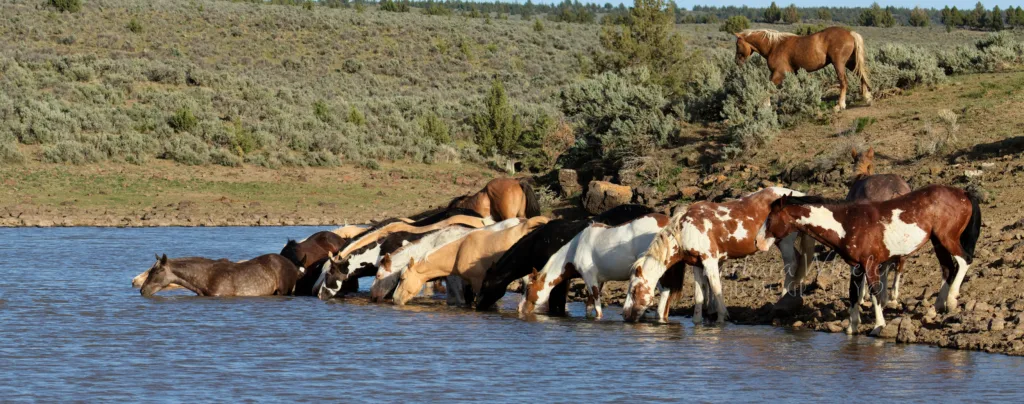
Before you panic and think this will be a dry blog (pun intended), hang on. Water is such an important part of wild horses’ lives (wild animals, in general). You can learn a lot about them by watching them at their watering holes. I want to share some of the drama- and fun that we have seen at waterholes in many of the herds we have visited over the years.
I promise you will be entertained and hopefully, educated a bit too. Of course, there will be lots of photos and as many videos as I think you can stand.
How Do Horses Get Their Water, Anyway?
I’m so glad you asked. There is not just one answer though.
Natural Creeks, Springs or Streams
Some places have year-round creeks or springs. Some of those creeks may appear dry but resurface in various places. The horses know where that is, even if we can’t find them.
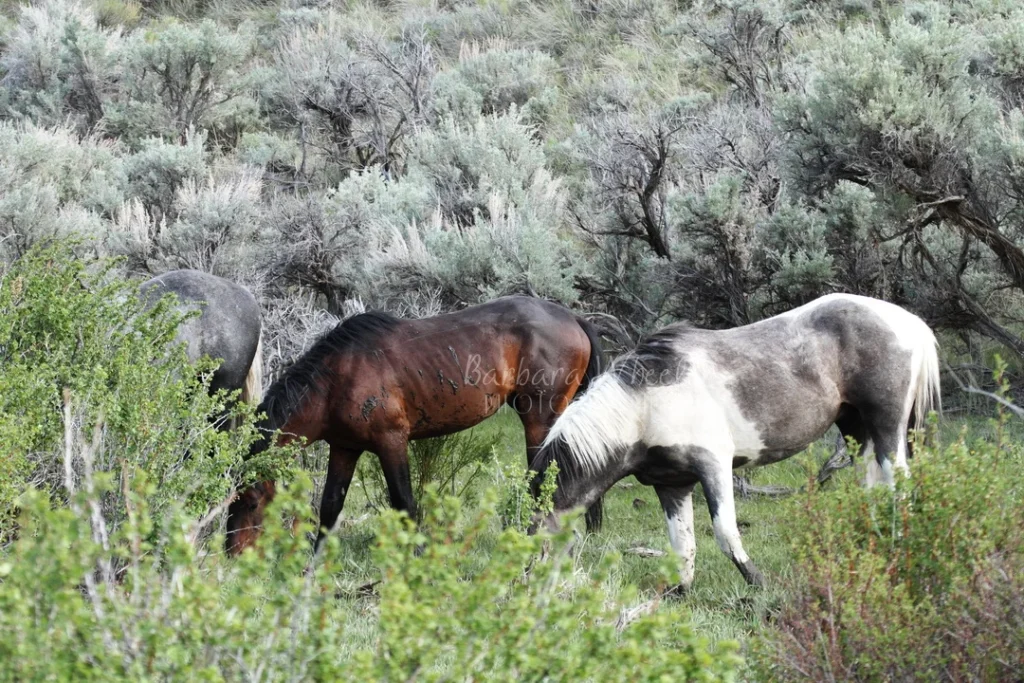
This is a year-round creek in Challis HMA in Idaho. This water will not disappear any time soon!
Notice how the sagebrush goes right to the edge of the creek. You can clearly tell just how far the water goes. The vegetation around the creek is lush- which is why you can’t see the horses well.
We had been visiting the South Steens HMA in Oregon for many years. Imagine our surprise when, in 2015, we saw Arrow’s band visiting a usually dry creek bed. It was a lovely scene.
Arrow’s band at a creek
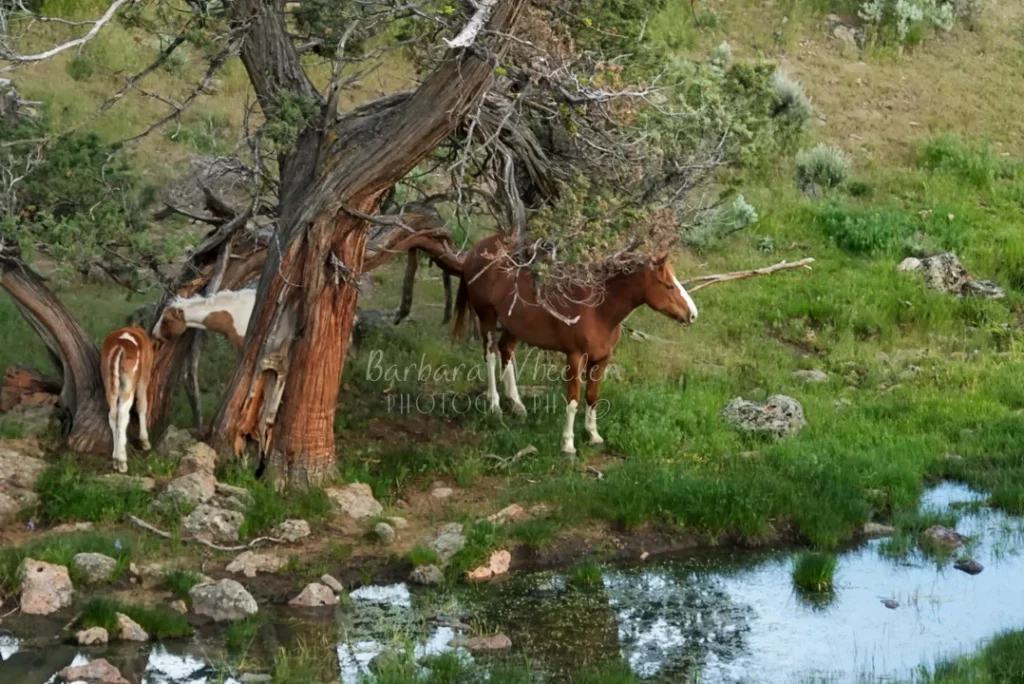
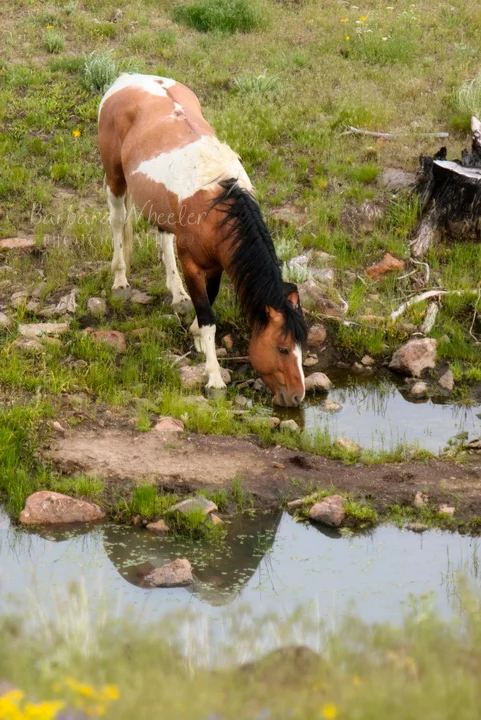
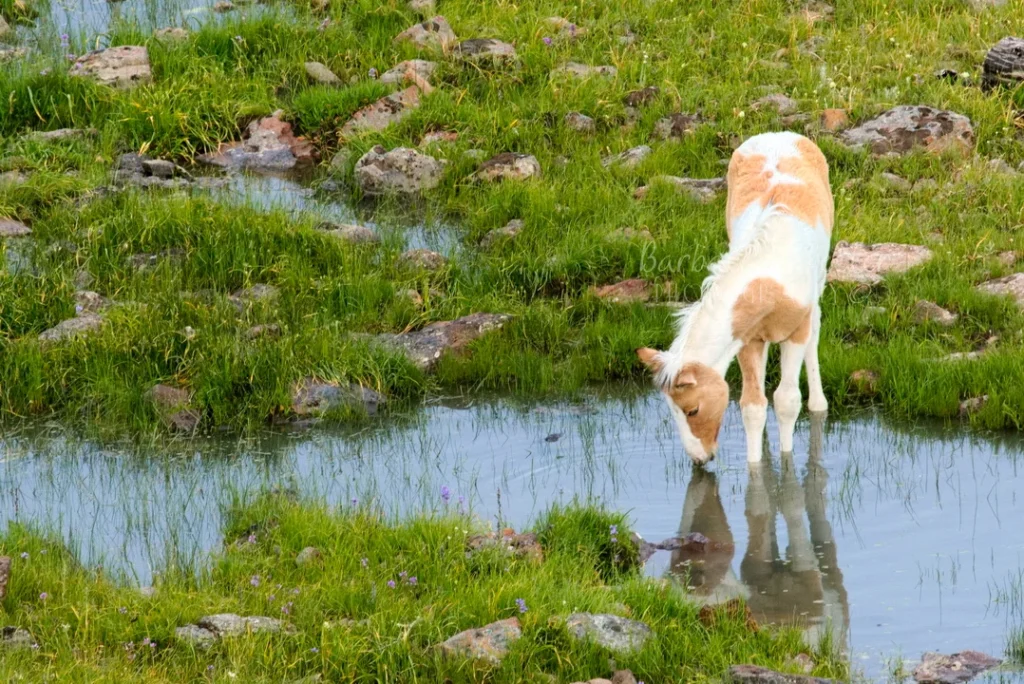
One of the most exciting experiences we had at Salt Wells Creek HA in Wyoming involved a nearly invisible creek near where we had set up our cameras on a bright June morning in 2017.
We had been there for almost two hours when suddenly, in the distance, I noticed a large group of horses running toward us. We delighted in watching nearly 100 horses come in to drink at a small stream.
Watch for the Curlies! And for the Pronghorn Antelope in the far background…
What an amazing sight this was!
As you can see from the beginning of the video, I was far away from where the first horses came in to drink. By the time it was all done, I nearly had horses in my lap. I hadn’t moved – they came to me.
More Commonly…
As lovely as natural creeks are, they are not the most common watering places we saw in our travels.
The BLM (Bureau of Land Management) has developed many water troughs or waterholes that are fed by natural springs. Of course, they stay filled as long as the spring has water.
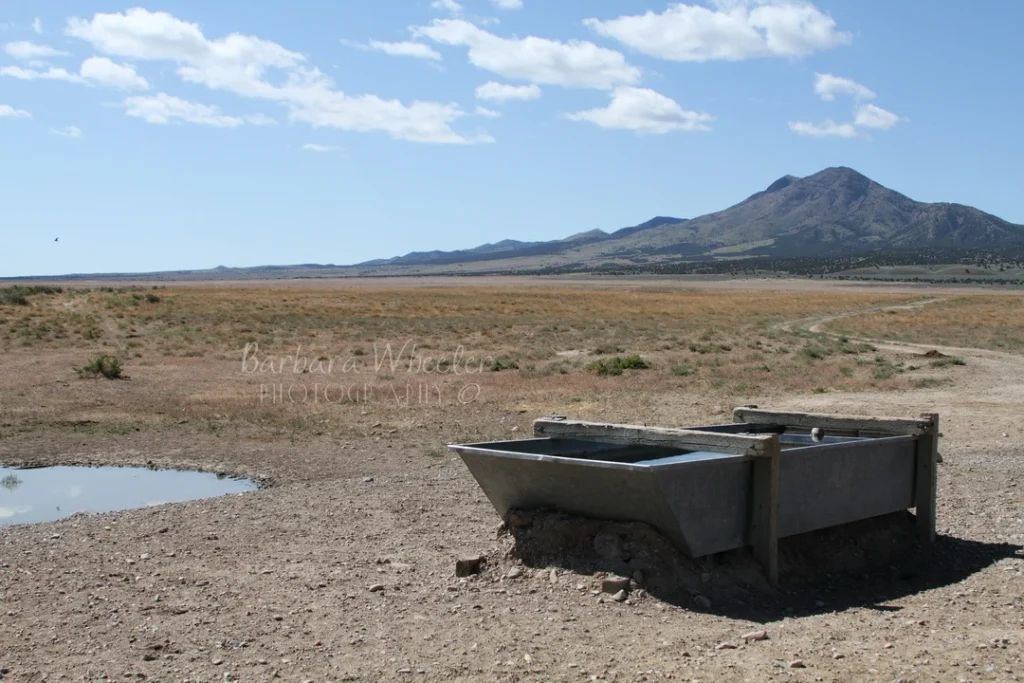
This trough in Utah is fed by a natural spring. Overflow dumps into a pond, which then empties into a creek bed.
The flow of water into many of the troughs is controlled by a regulator like modern toilets have. When the water level drops, the “ball’ drops and water is released into the trough. Some troughs have no such regulators. Water just runs into (and out) of them freely.
Most of these troughs have been there for decades. However, it seems the horses are still not very used to those regulators. More about that later.
We have seen troughs with overflow ponds that were dry to come back a couple of weeks later and find it overflowing with water. The hundred horses or so that had been frequently using it had moved on to another water source and the water reappeared like magic!
Even More Common
Probably the most common type of waterhole that we have seen, is a natural spring which fills a bermed up area, like a man-made pond, created specifically by the BLM for wildlife. They are frequently shared by cattle and other animals in the area, such as Pronghorn Antelope or elk. There is generally nothing pretty about them.
These vary from barely scraped out depressions in the ground to very high berms on two or three sides.
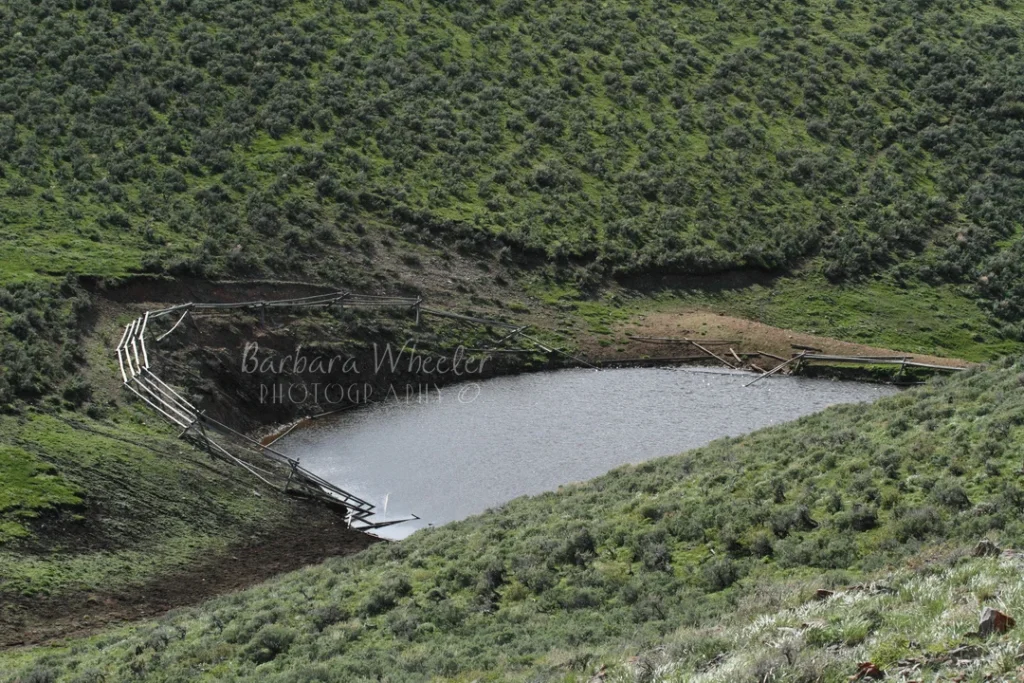
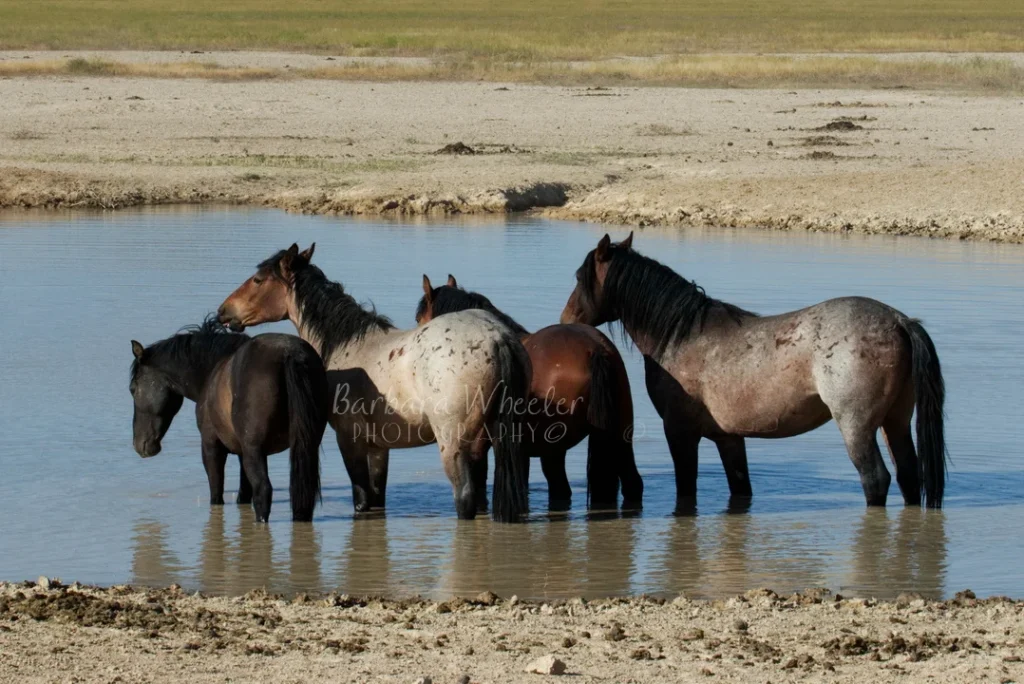
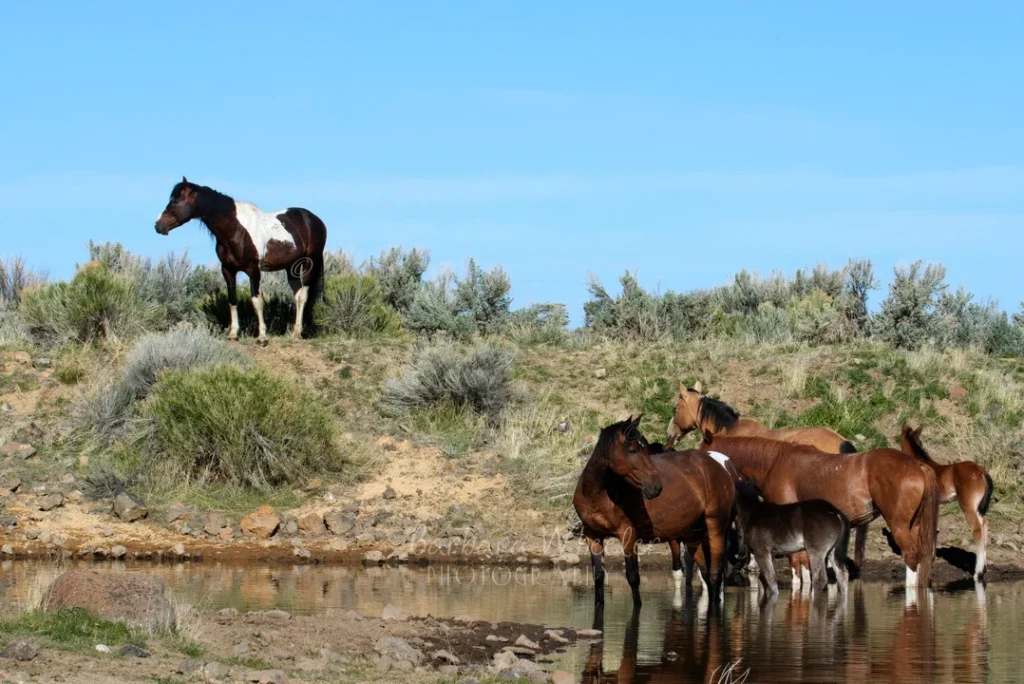
The water in these waterholes is frequently muddy. This does not deter any wildlife from using it. All animals, including horses, will drink out of a mud puddle, if there is one to be found.
We have found one BLM waterhole that was actually pretty. We’ve never seen one before or since that had wildflowers around it! Of course, it is likely this waterhole isn’t used much, which is why it was so pretty.
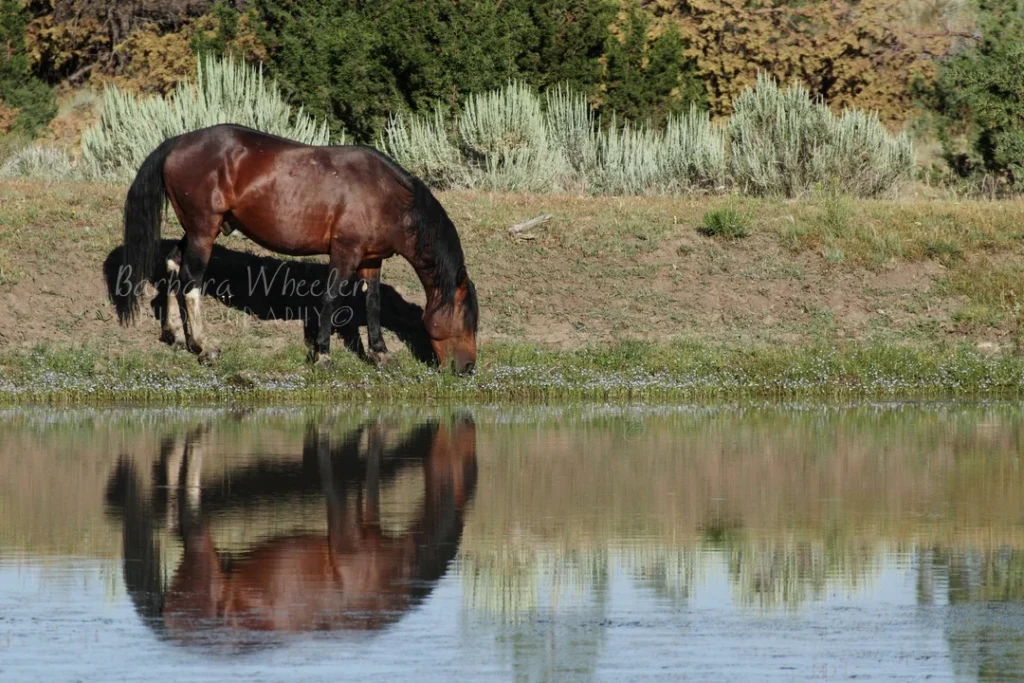
Windmills
Windmills have been used to pump water from wells in many western states since the days of the pioneers. It’s not unusual to see them even now. We have seen windmills that pump water into large water troughs in several HMAs, most notably in Piceance Creek. Of course, it depends on the depth the well is drilled to, but I was told by a wild horse specialist years ago that they only pull water from about 30 feet.
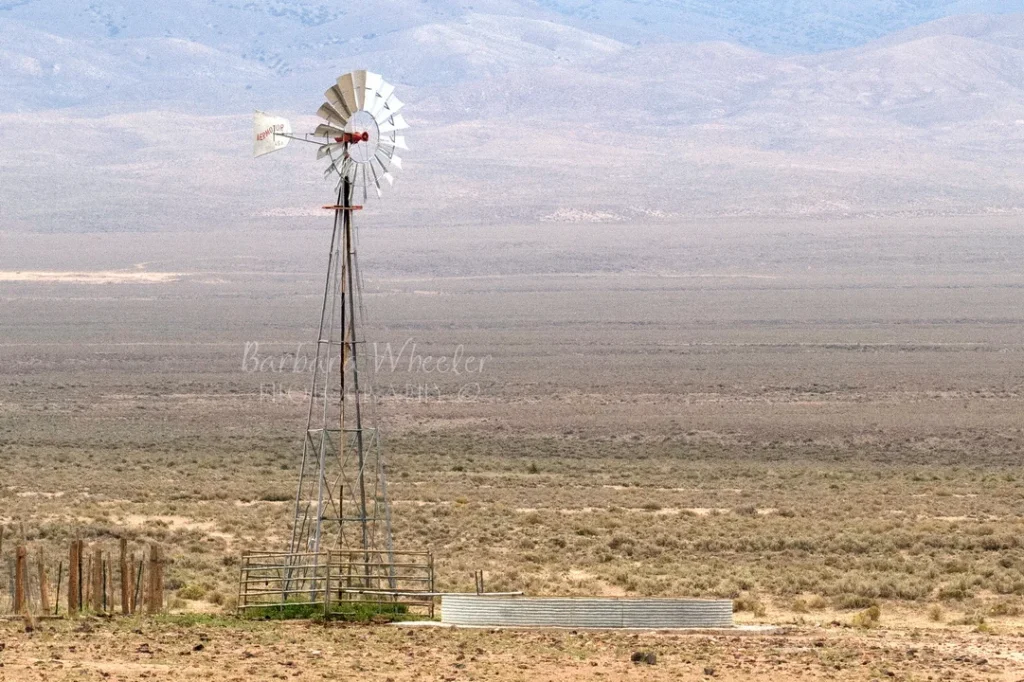
Most troughs are not this large. I would assume the size would be determined by how many animals are expected to use it and how much water is in the well.
Because windmills do not pull water from deep in the ground, it was not unusual to see the troughs dry.
Solar Wells
More recently, the BLM has been installing solar pumps/wells. These will pump to a greater depth than a windmill.
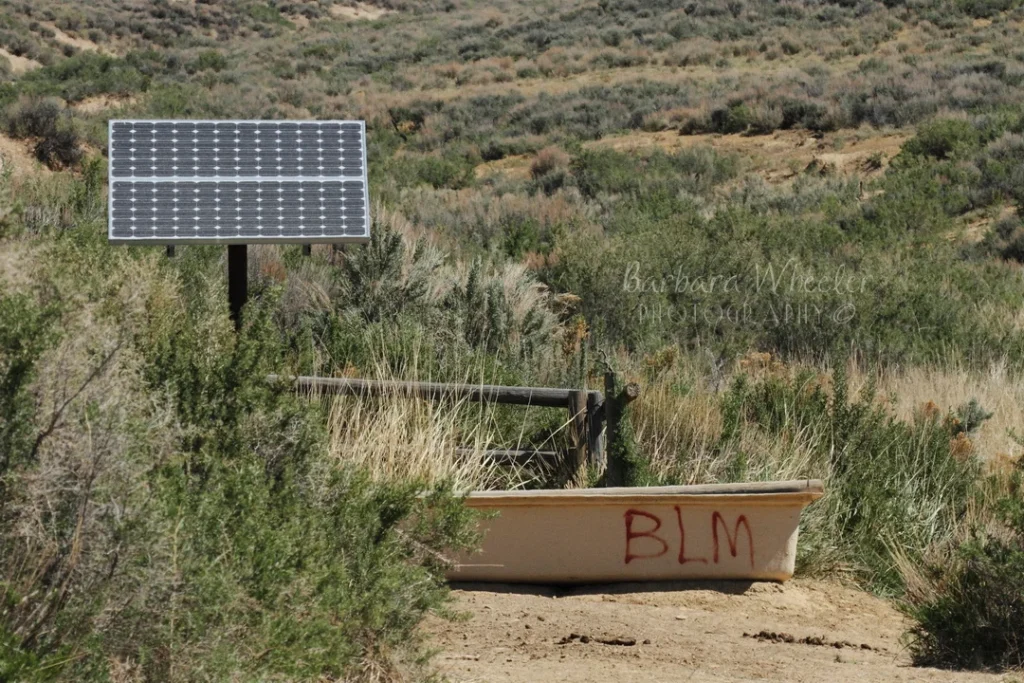
Though they are likely in many places, the only solar wells we have seen are at Sand Wash Basin HMA in Colorado.
This particular trough has a regulator on it. When the water level drops, it automatically pumps more water in. More about those regulators later.
Rivers & Ocean
There are a handful of herds that live near or on bodies of water. The Salt River horses in Arizona literally live beside the Salt River – and spend much of their time on, in or near the river. It is lush and green right along the river but only a few yards away you will encounter desert.
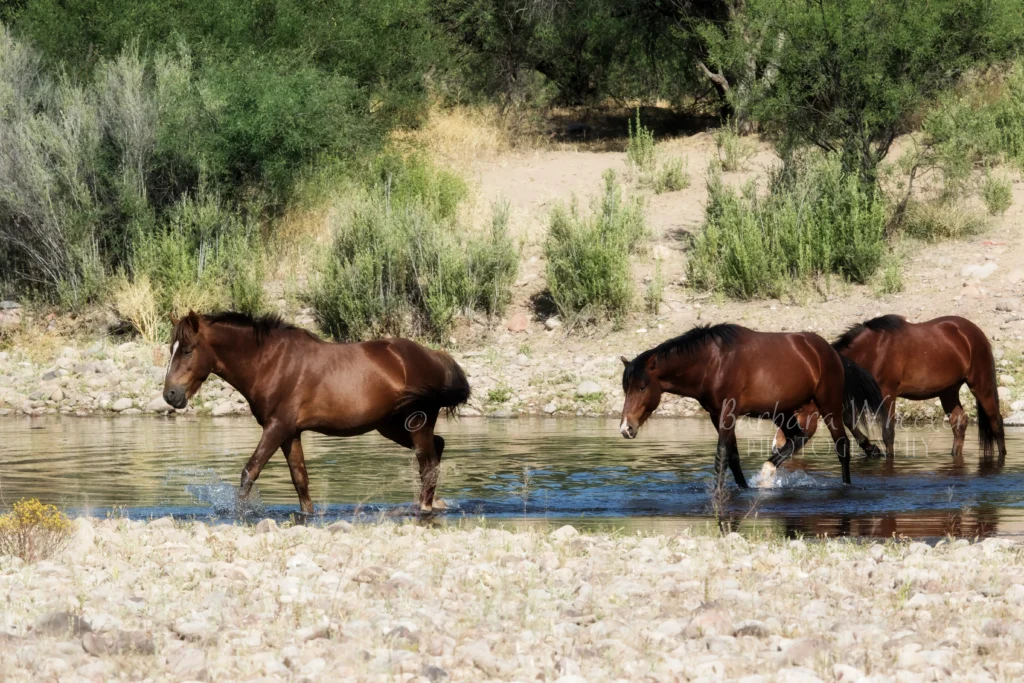
Many herds in the Eastern US live on the ocean, including the Corolla, Chincoteague, and Shackleford herds. There are also wild horses on Cumberland Island, Carrot Island, Town Marsh and others. It’s fascinating for a western girl to see horses on sandbars, eating salt water grasses!
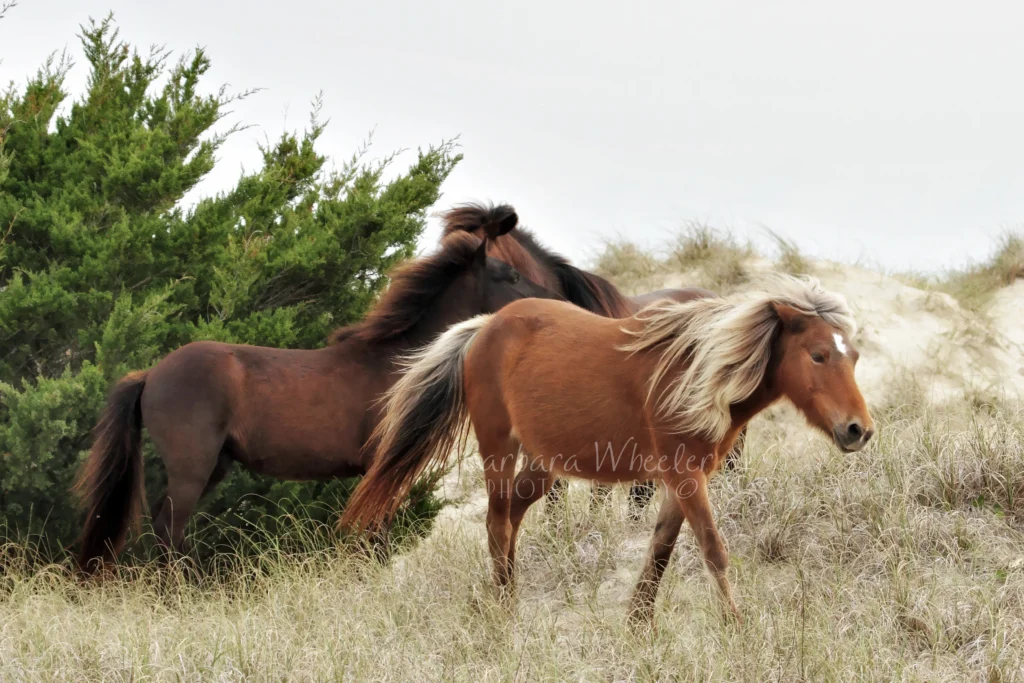
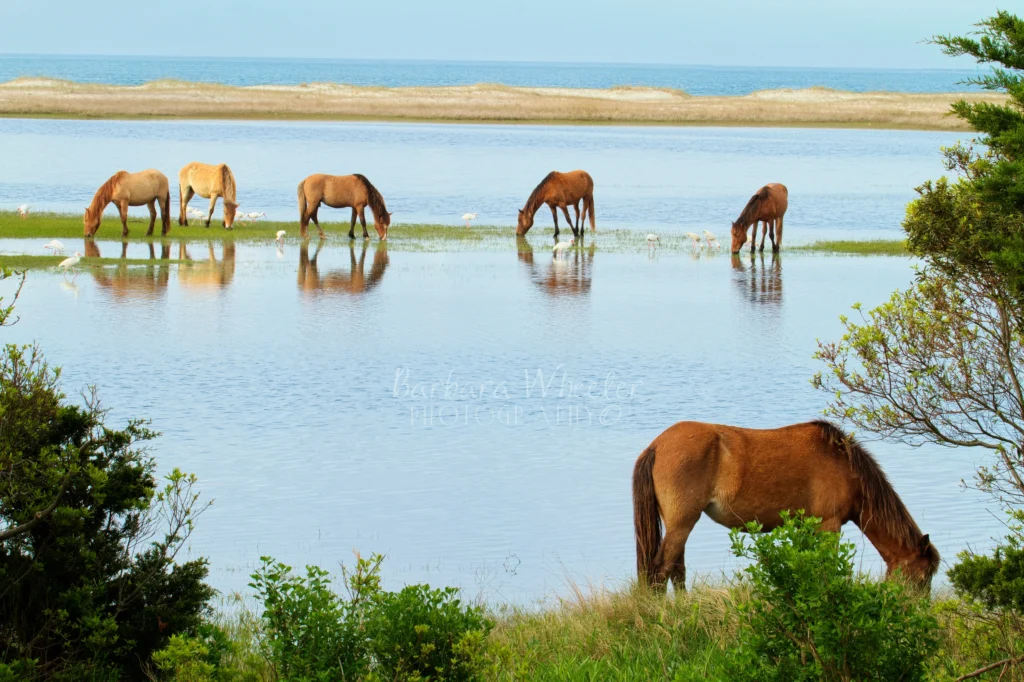
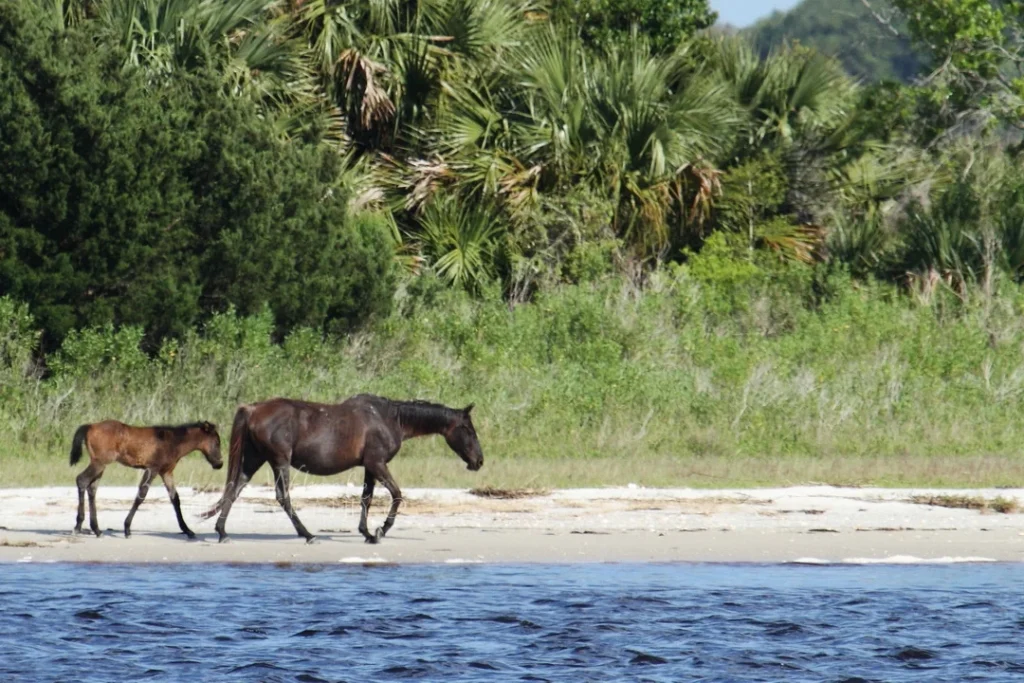
Most horses who live along the seashore primarily eat the saltwater grasses that grow in the marshes. They eat almost all day just to get enough nutrition from this diet to sustain themselves. The salt content of the grass is very high. To compensate for all the salt in the grass they drink twice as much water as a normal horse. This is why their bellies appear so bloated.
Now that all the mechanics are done, let’s have some fun…
Rhythms
Going to water, whether it is a trough, a creek or a bermed pond, is part of the wild horses’ routine or rhythms. How many times they go to water in the course of the day, varies according to the weather conditions, but undoubtedly it is several, including in the middle of the night. Some herds go to water like clockwork. You can go there at 4:30 and they will show up just about that time. Others seem to come and go randomly.
Horses will drink from 10 – 40 gals of water a day depending upon temperature, and movement. Standing at rest in a stall on a nice temperature day and eating dry hay, they well drink 10-12 gals. Moving around out on the desert –most would prefer 25 gals. Wild horses do obtain some moisture from grasses in the spring and therefore get some water from plant material. Some of the horses who live in dry desert climates seem to get by with less water than the more Northern horses.
So, Who Determines When to Go to Water?
We have watched horses going to water dozens of times. It’s a funny thing to watch. One minute the horses are grazing peacefully or sleeping or grooming or doing other horsey things. The next thing you know, they are all headed in one direction. It is very clear they are going somewhere and that somewhere is often the waterhole.
When you start really paying attention, you quickly see that it is usually started by a lead mare in one of the bands. It doesn’t seem to matter which band or where they fall in the whole scheme of things, but band after band will start to fall into line. It is interesting that when a bachelor band goes to water, it does not usually start the parade. From what I can see, though there are always exceptions to the rule, it is always a lead mare in one of the bands. Now the mare might on occasion think the bachelors have a good idea and follow, but it usually seems to start with her.
Off she goes!
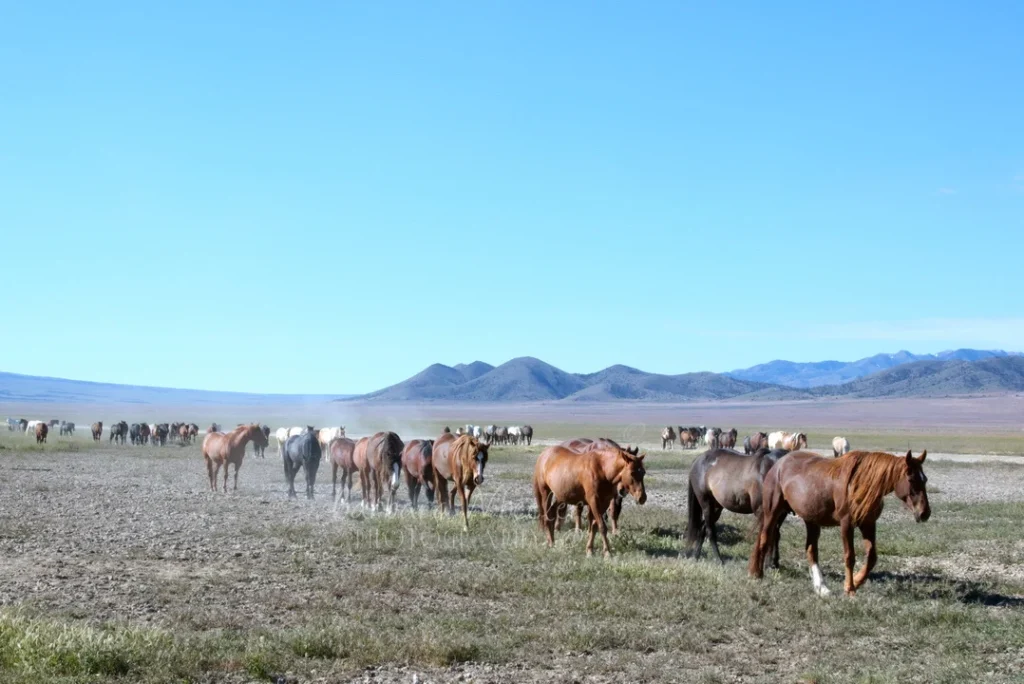
The long trek to the waterhole. There is music in this video because the wind was so loud that day.
Over Hill and Dale… with Me in Tow
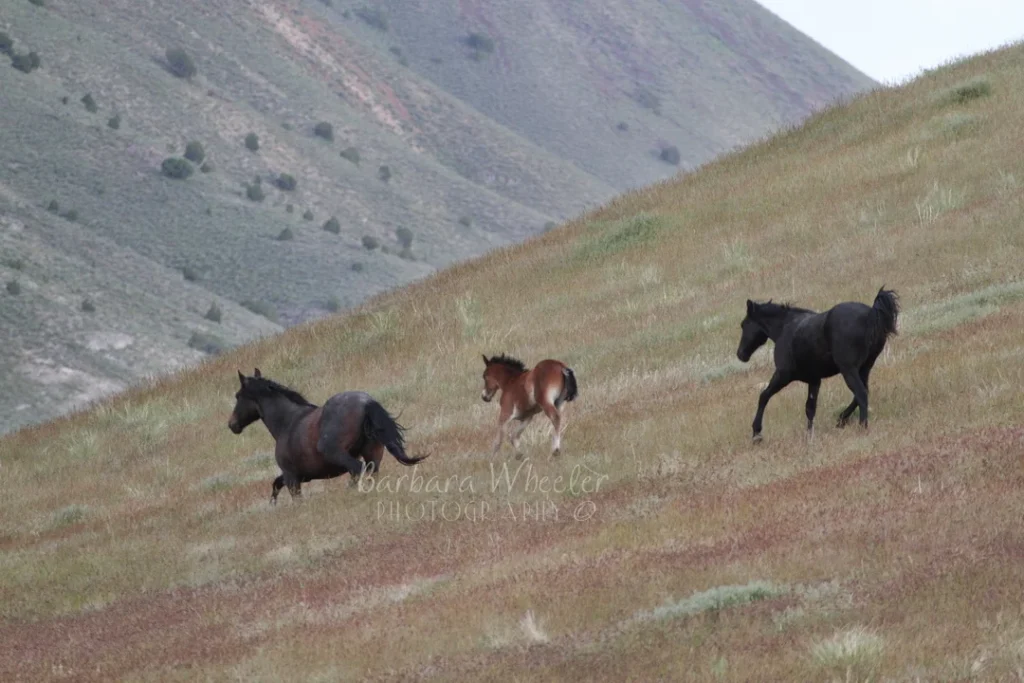
Many of you are familiar with the story of me following a large group of Onaqui horses to water years ago. It’s my favorite story of the two stories I know.
Well, one of my favorite of one hundred stories, then! LOL
Just like it usually happens, one mare decided it was time to go to water. She started off, and the rest of the near 100 horses followed. I followed too.
We had been in the very same spot with the very same group of horses the day before. They had taken the easy way down to the water trough and I had easily followed. Silly me. I thought she was going to take the same route. I thought I knew where we were going. Right!
She did NOT use the same (easy) route.
Let me tell you! They led me on a merry chase over hill and dale, up, down, over, up again… By the time I figured out where we were (about 45 minutes later), we were on a very high hill! Absolutely no way was I going down that! I had to backtrack and sidehill down to get to the meadow where Marty was waiting with the truck (someone had to go for the ‘wheels’). Lo’ and behold, as soon as they got down that steep hill to the meadow, they walked down the road to the very same water trough they had gone to the day before. Only this time they (and me) took the long way around! Crazy horses!
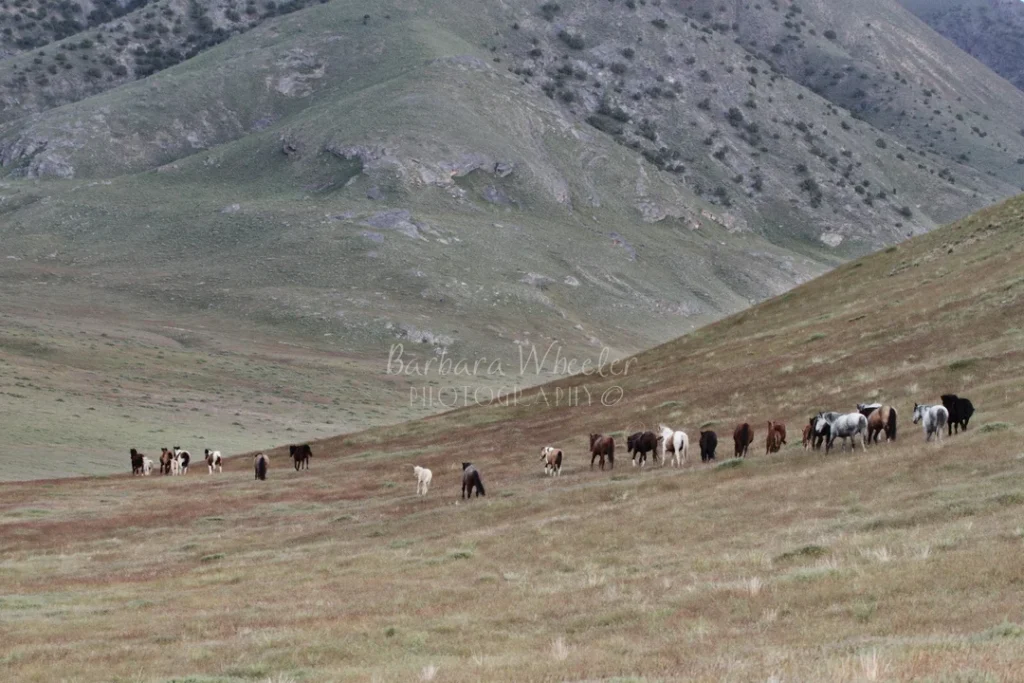
Yes, that valley below is where they intended to go! YIKES!
The lead mare will almost always lead the band, but somewhere along the way she will drop back. The stallion will then usually lead the way when they get close to the waterhole, trough or creek.
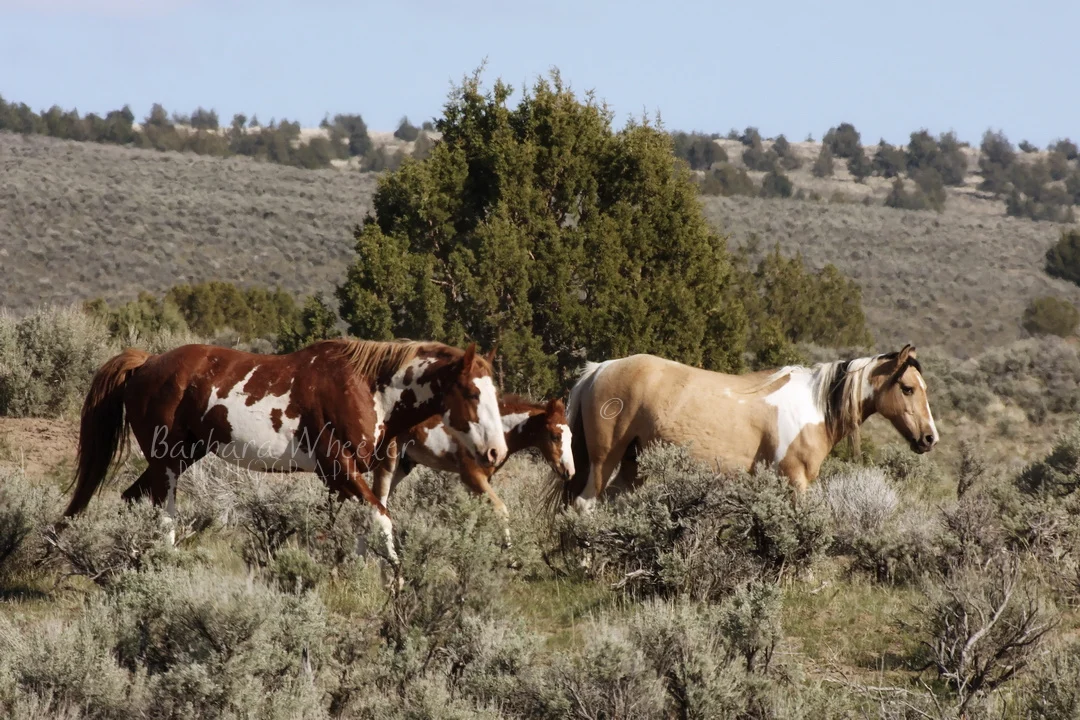
Charm (R), Ranger and their 2009 foal on their way to the waterhole
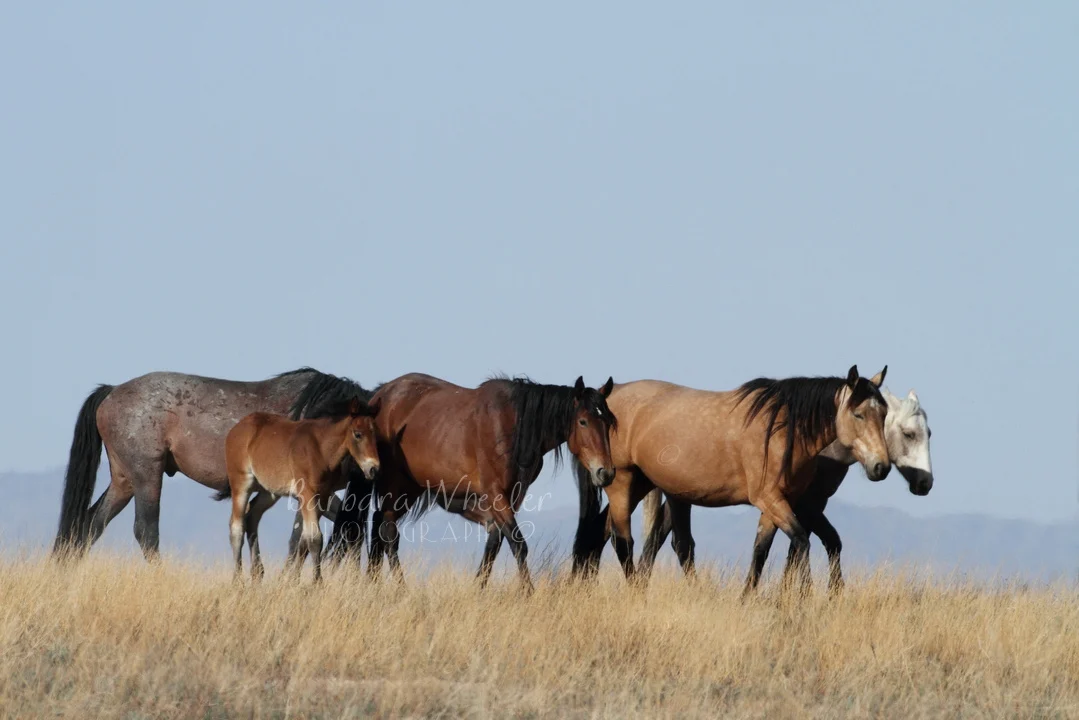
A band from the Onaqui herd on their way to the waterhole
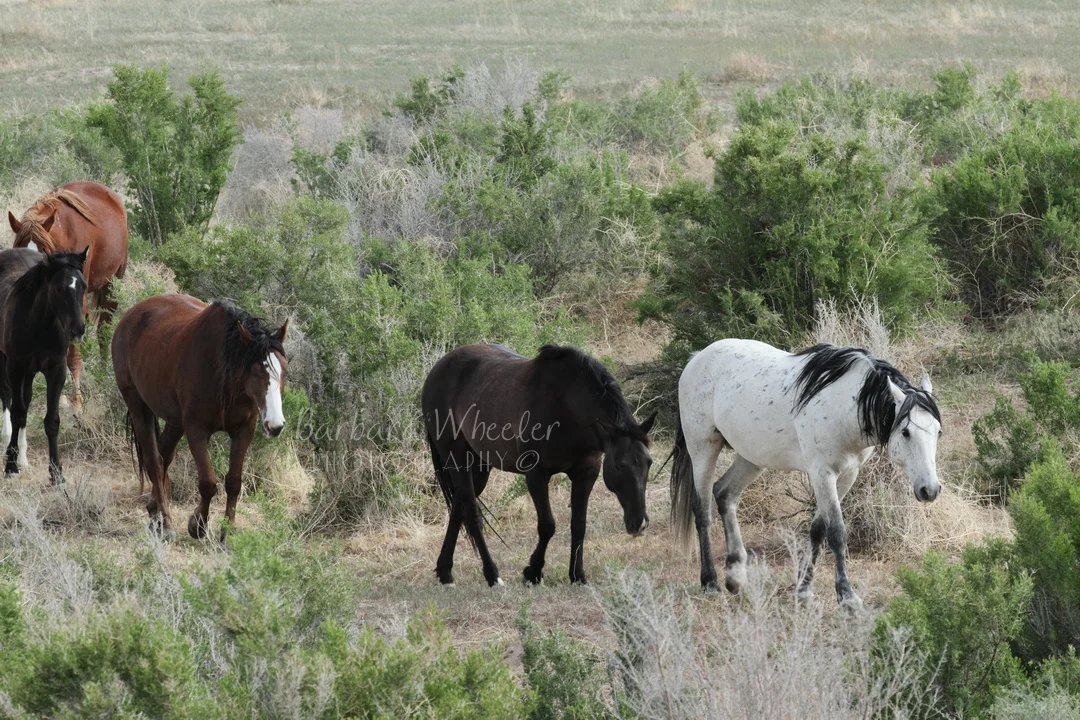
The band stallion is in the lead, Onaqui HMA, UT, 2012
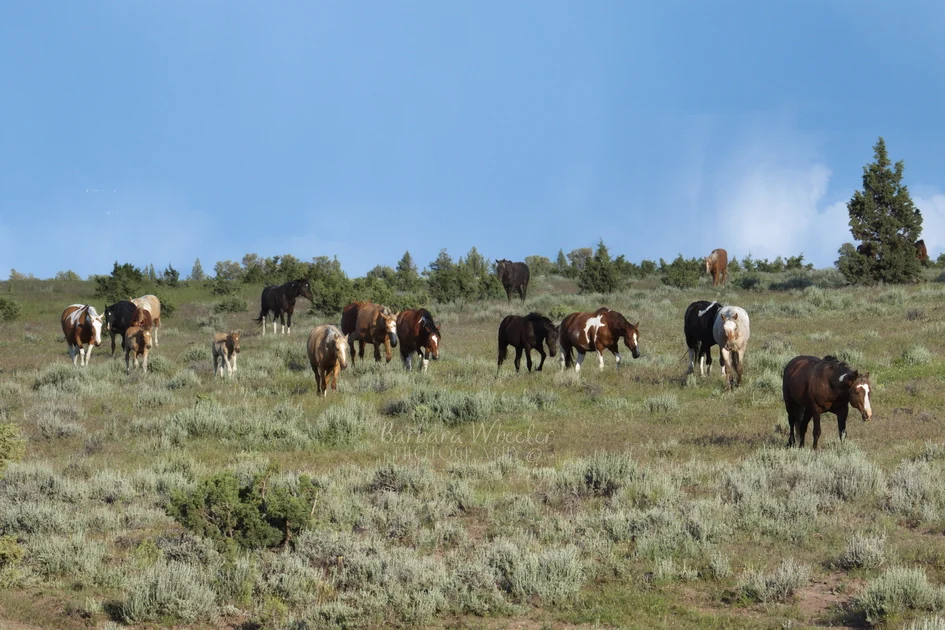
The Silver Bay and his large band, South Steens HMA, 2015
Time for a drink…
One of my favorite waterhole images is of Moondrinker and Stargazer (Onaqui HMA, UT) escorting their little sister to the waterhole. At the time, Moondrinker (L) is two years old and Stargazer (R) is one year old.
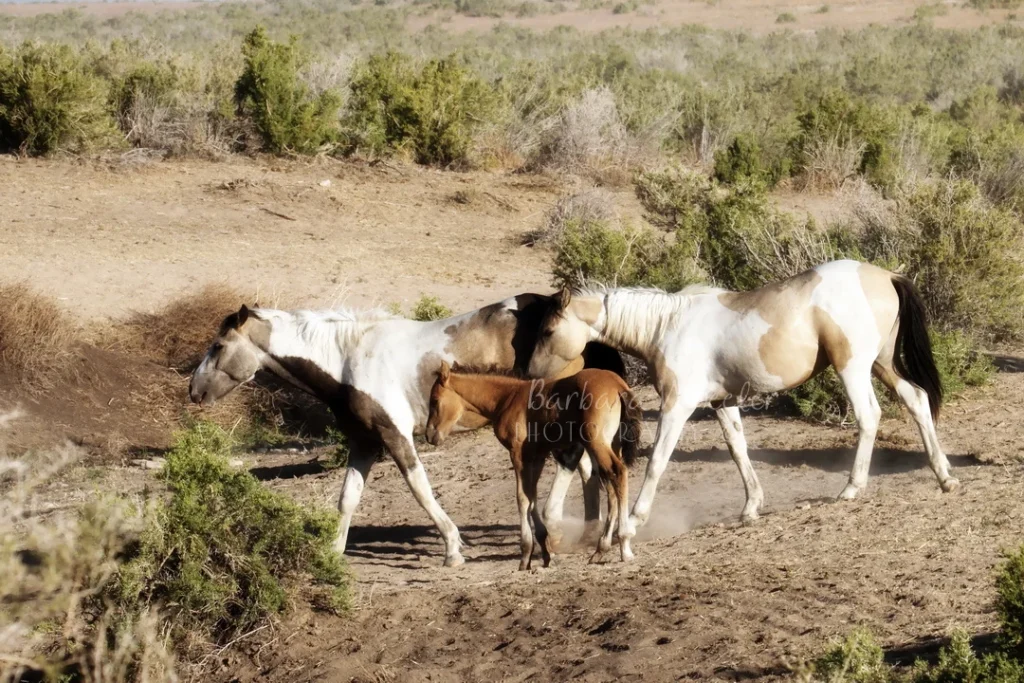
Even the youngest foals will go in the waterhole with their dams close by their side.
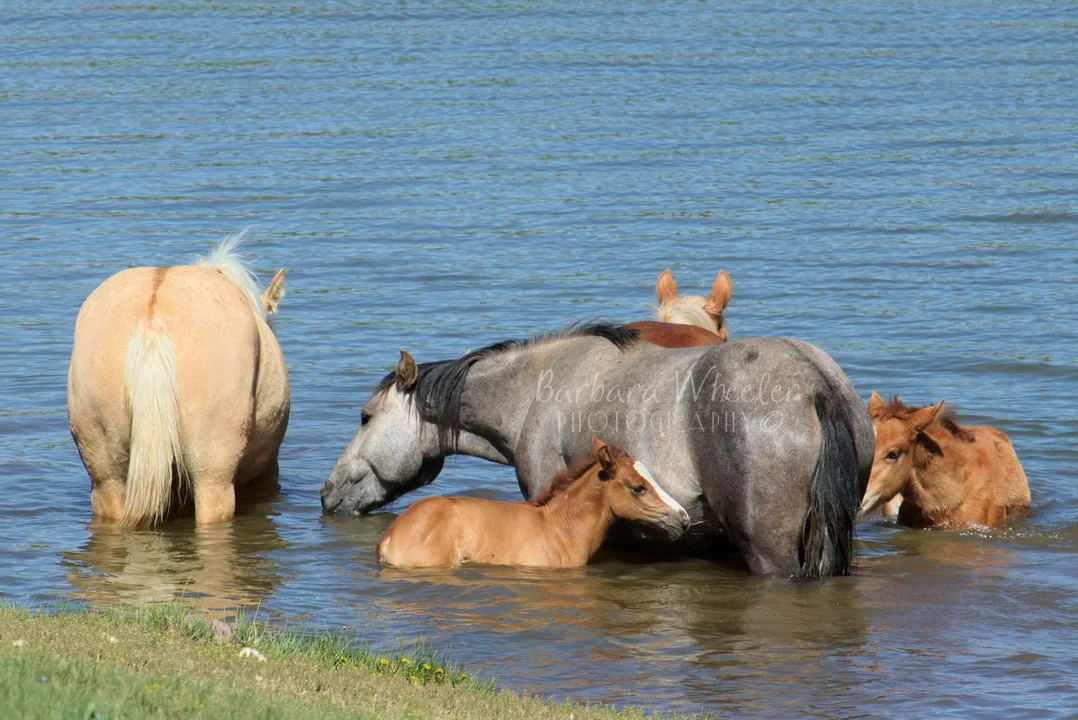
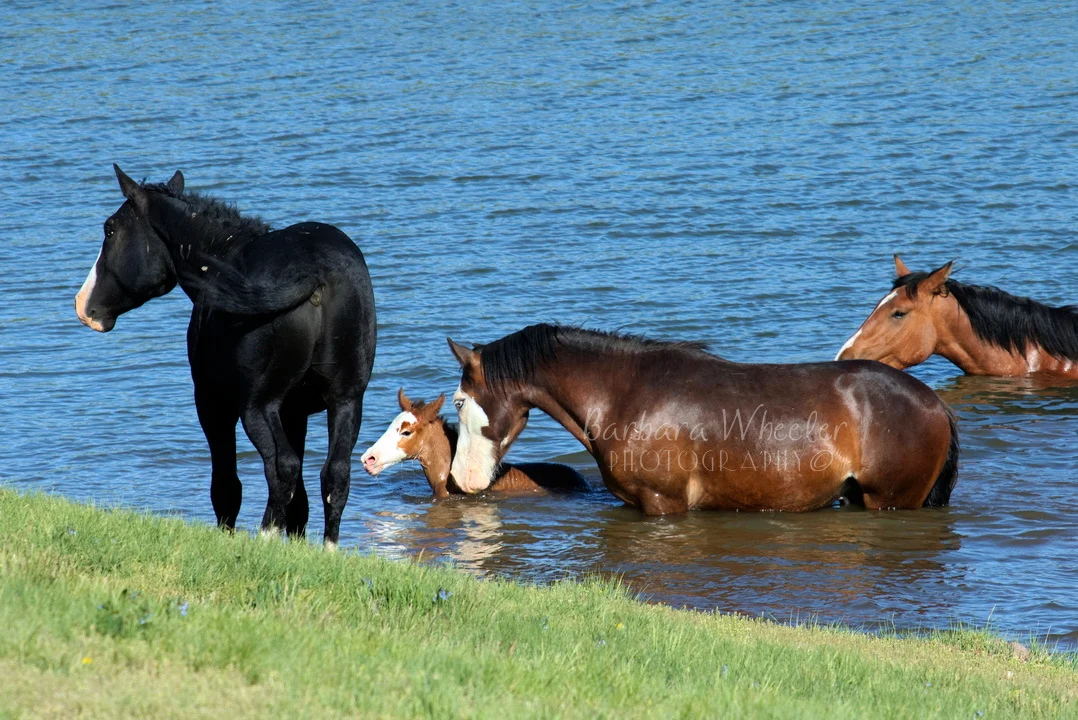
Salt Wells Creek HA, 2017
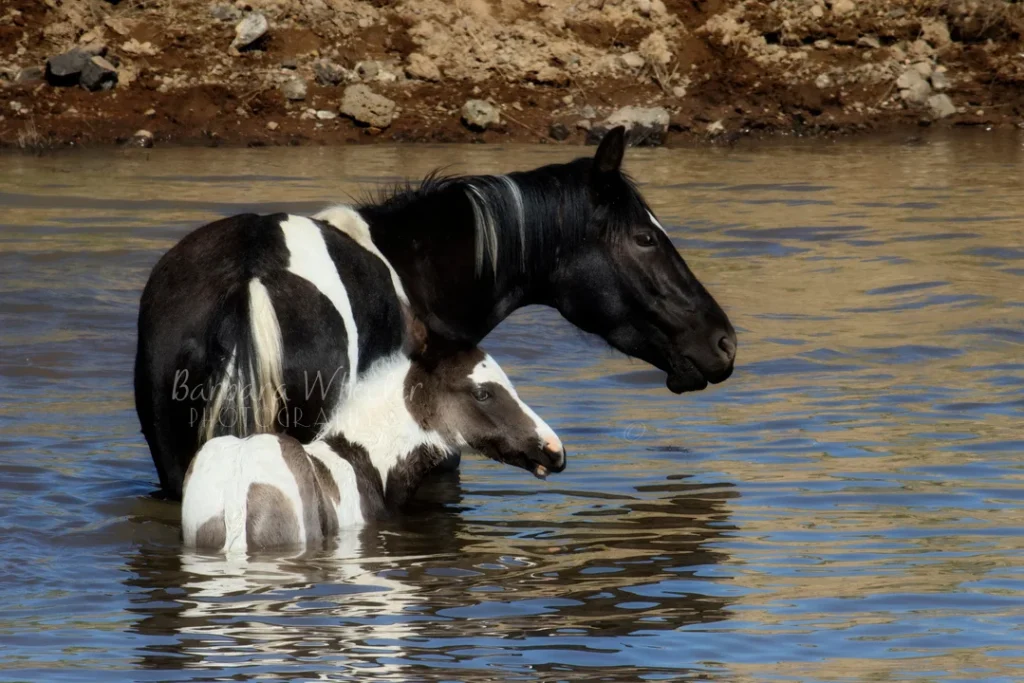
Rules and Protocols
Rules and protocols about the waterhole may differ from herd to herd, but I can assure you- there ARE rules.
Generally, the mature stallions and their bands go in first. If there are a lot of “big guys”, they still seem to take turns, though there can be tension just as they get to the waterhole. Next come the younger stallions and their bands, then the stallions with just one or two mares and finally the bachelors. We have seen bachelor bands arrive at the waterhole earlier than the other bands and they will stand off a way and wait until the other bands water, sometimes waiting a long time, if it’s a big herd. They know their place!
Many of you probably recall the video I did of the wild horses running to the water troughs and pond. The whole video was about 15 minutes long, so you saw a little snippet of it. In this section, the horses have already come in single file and are breaking up to go to the trough in front, as well as a pond and trough in back. Watch how certain bands stand and wait their turn.
Watch for the horses who are drinking to suddenly jump back. The regulator has just dropped and water starts going into the trough again. Now, I suspect this trough has been there for decades too, but they still don’t trust that the water suddenly starts pouring in!
Cedar Mountain HMA, UT, 2012
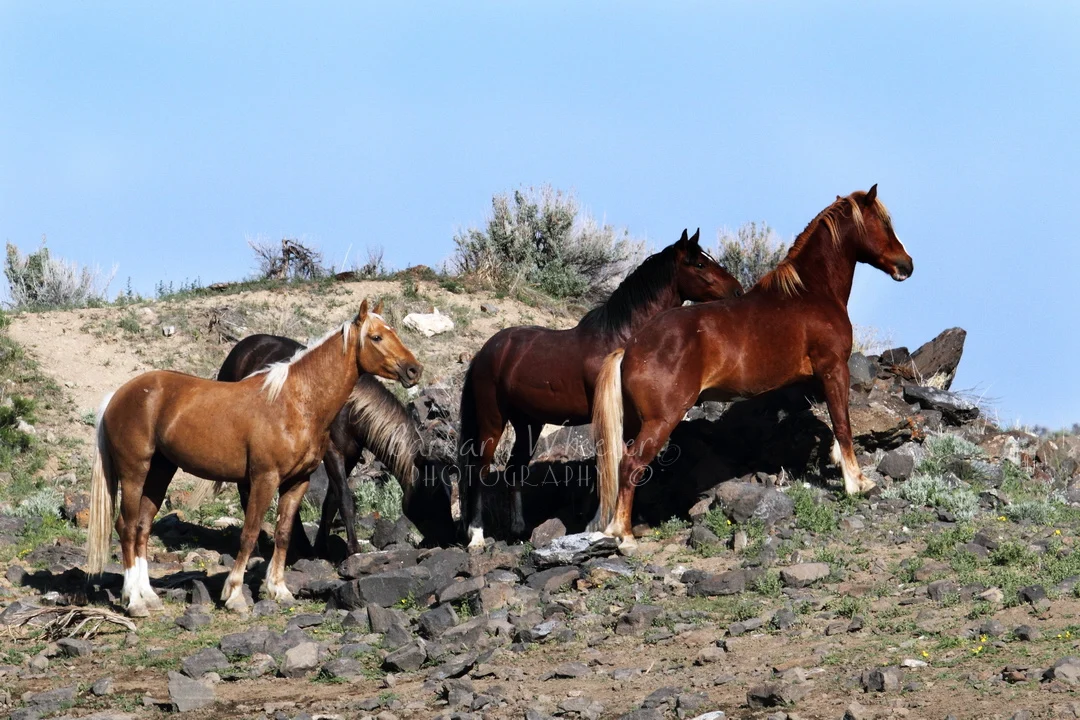
Bachelors waiting for their turn at the waterhole
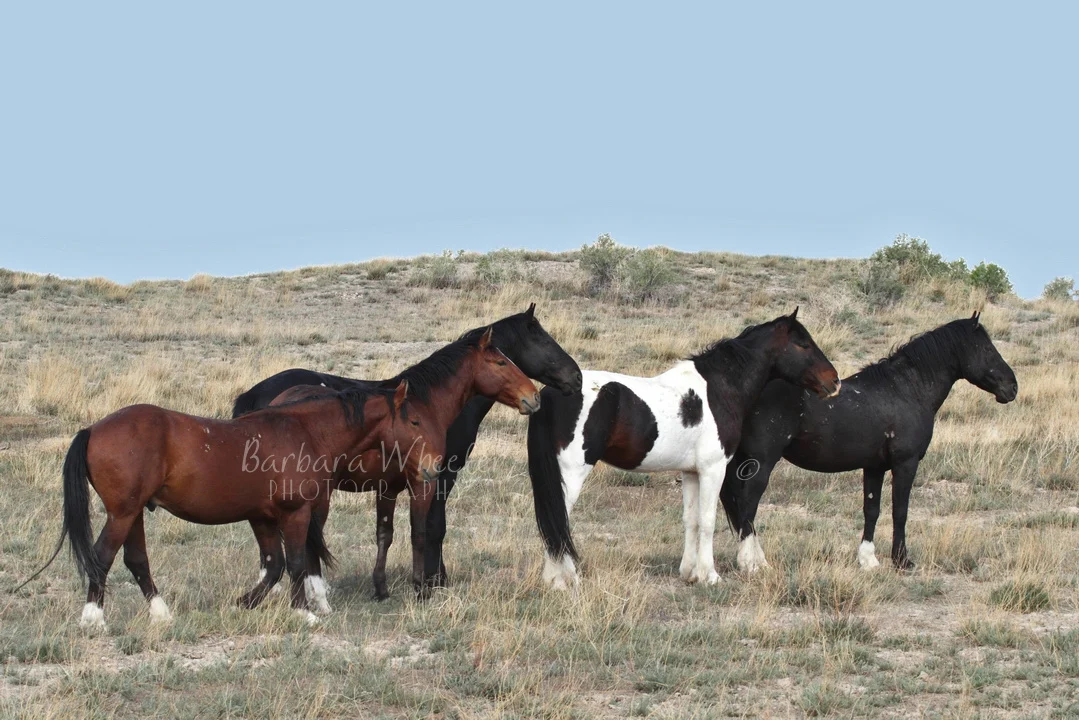
South Steens HMA, OR
Interestingly, the protocol you see at a waterhole or trough seems to be different at creeks and ponds, even when it is the same herd. You probably noticed that in the earlier creek video.
I suspect this is because horses have a lot of access, not just at a single point, like a trough.
Fun and Games
Any wild horse photographer will tell you that waterholes are fun places to be. There is usually a lot going on. And you can often be surprised by what happens.
Get a couple of family bands together at a trough or waterhole and trouble is bound to erupt! Usually it’s nothing serious, just a whole lot of posturing and scuffles.
Stallions get too close to another stallion’s mare. They get bumped. They look sideways. Who knows sometimes what sets it off? But there is almost always action!
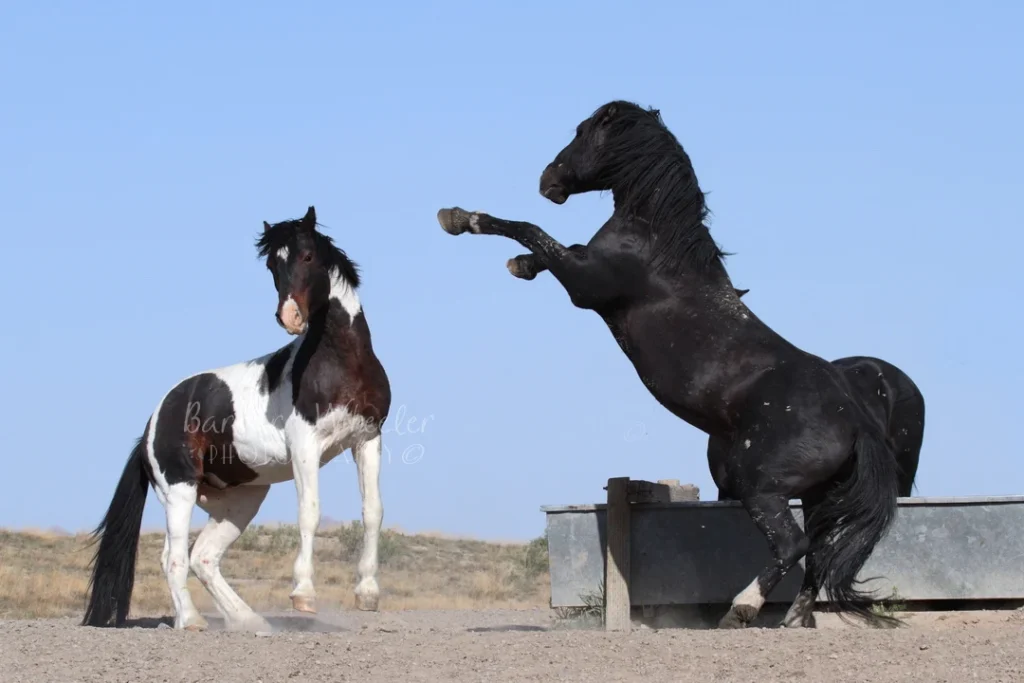
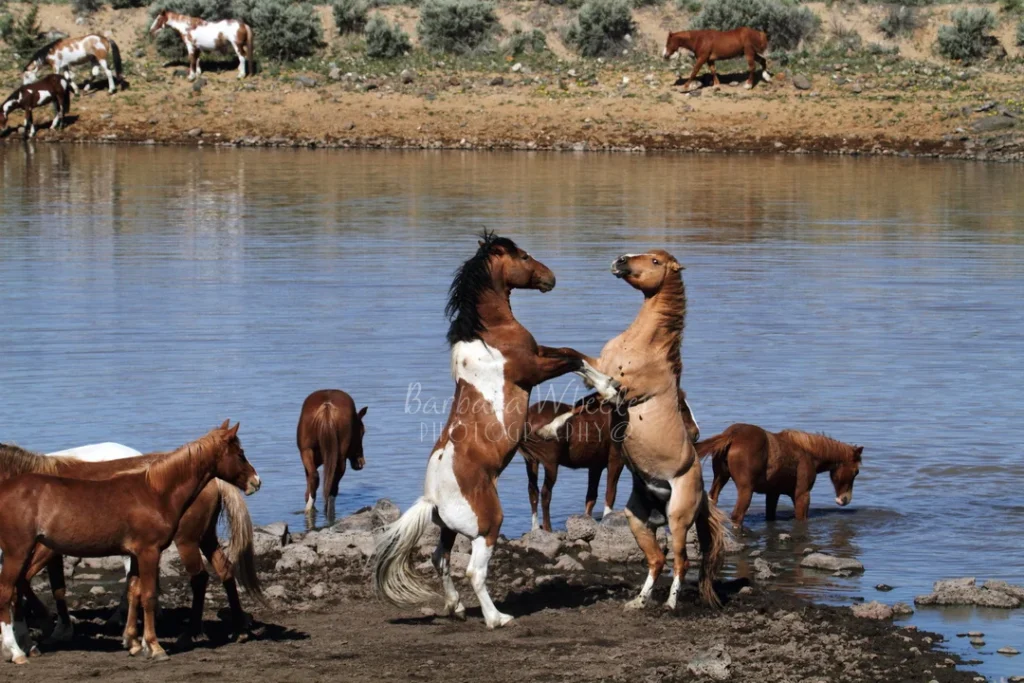
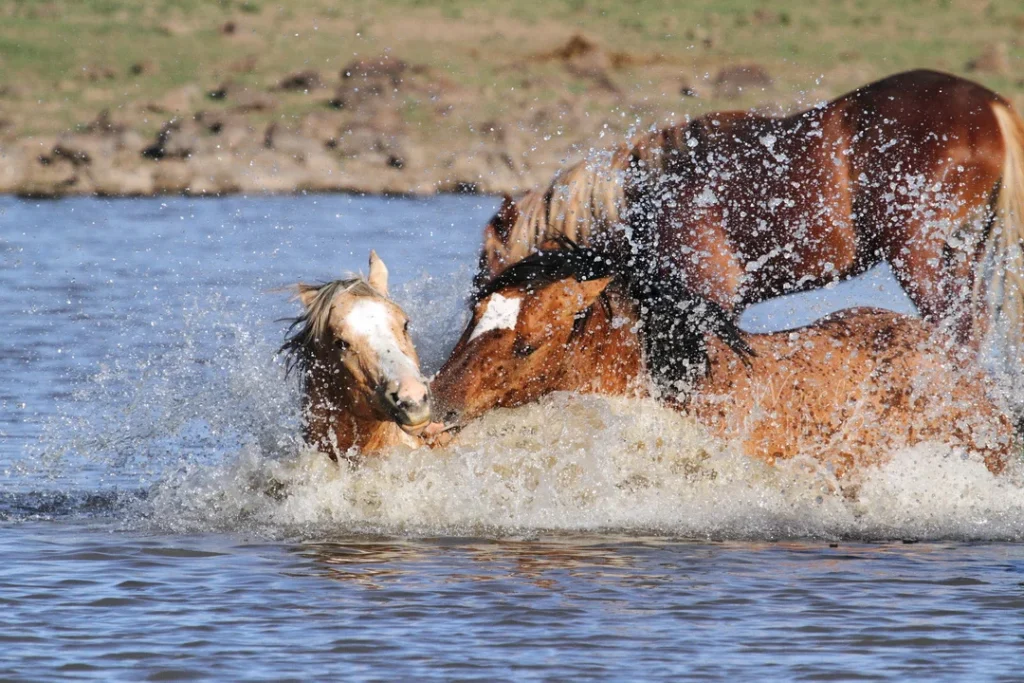
On rare occasions, the waterhole is actually deep enough to swim in. The horses seem to enjoy this immensely.
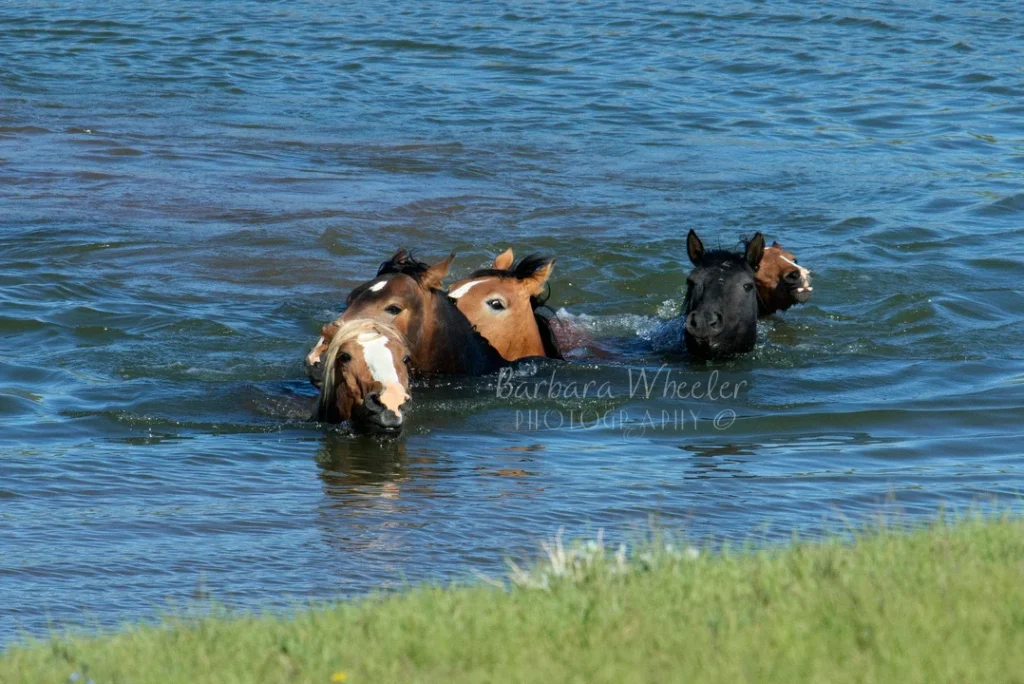
But even if they can’t swim, they can roll and splash!
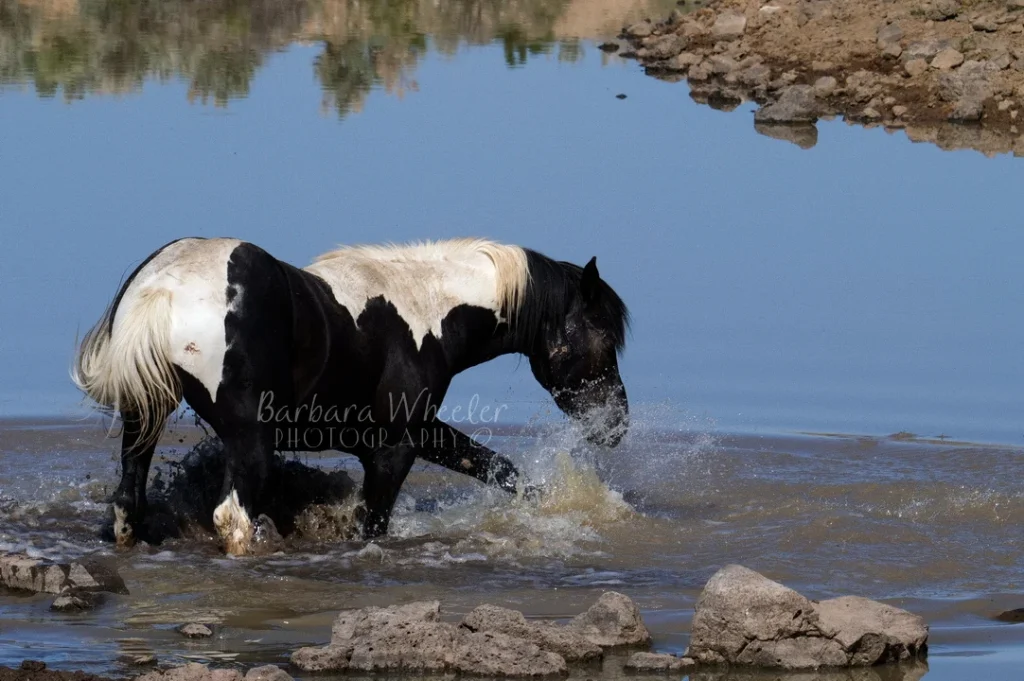
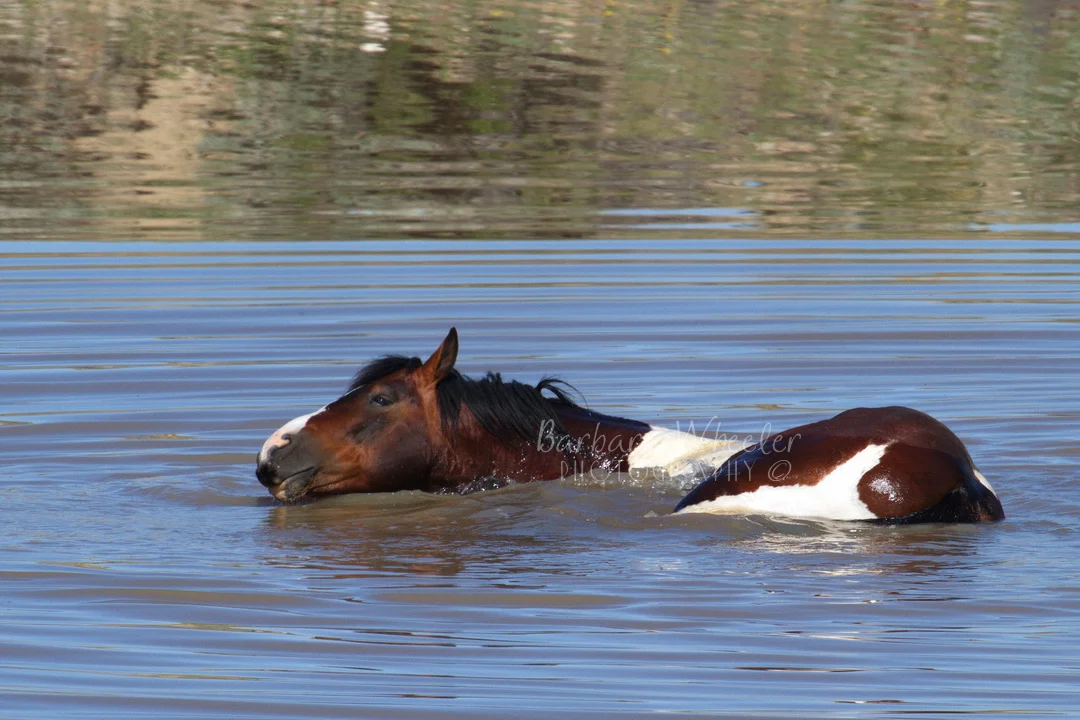
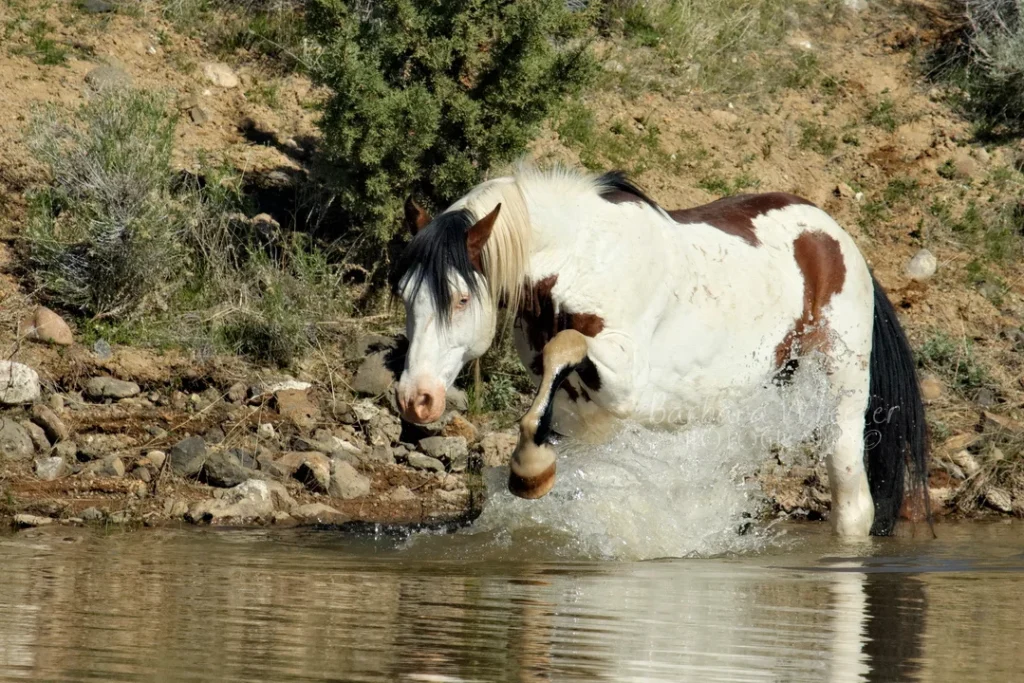
Domino. Cortez and Shaman are all from the South Steens HMA in Oregon.
Most of the time, the horses drink and then leave single file again. Occasionally, though, they will hang around and eat or sleep – or roll.
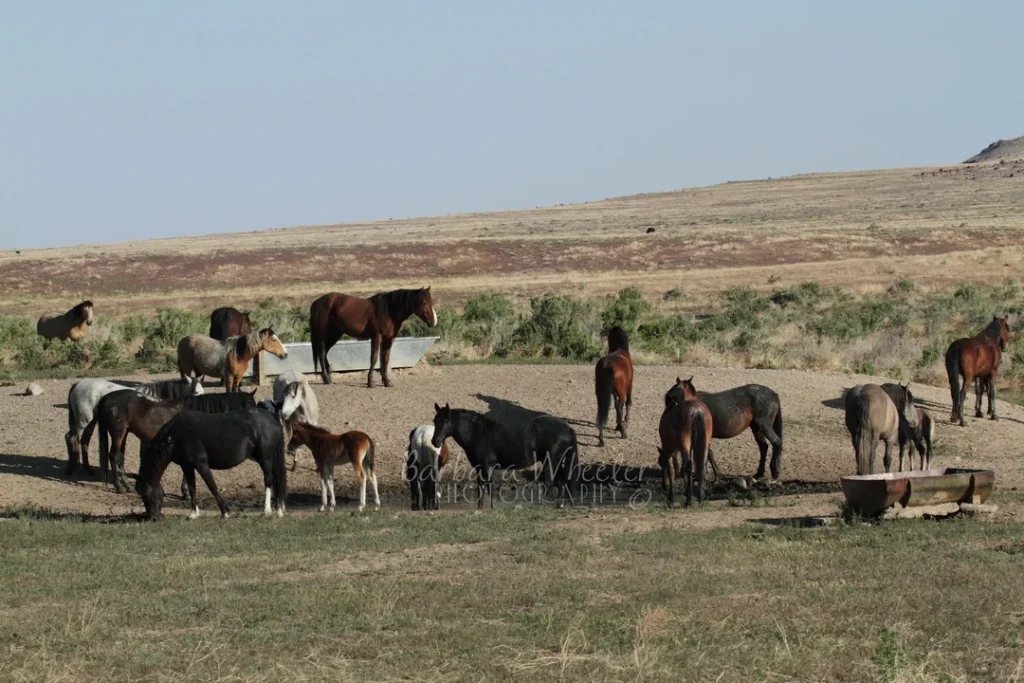
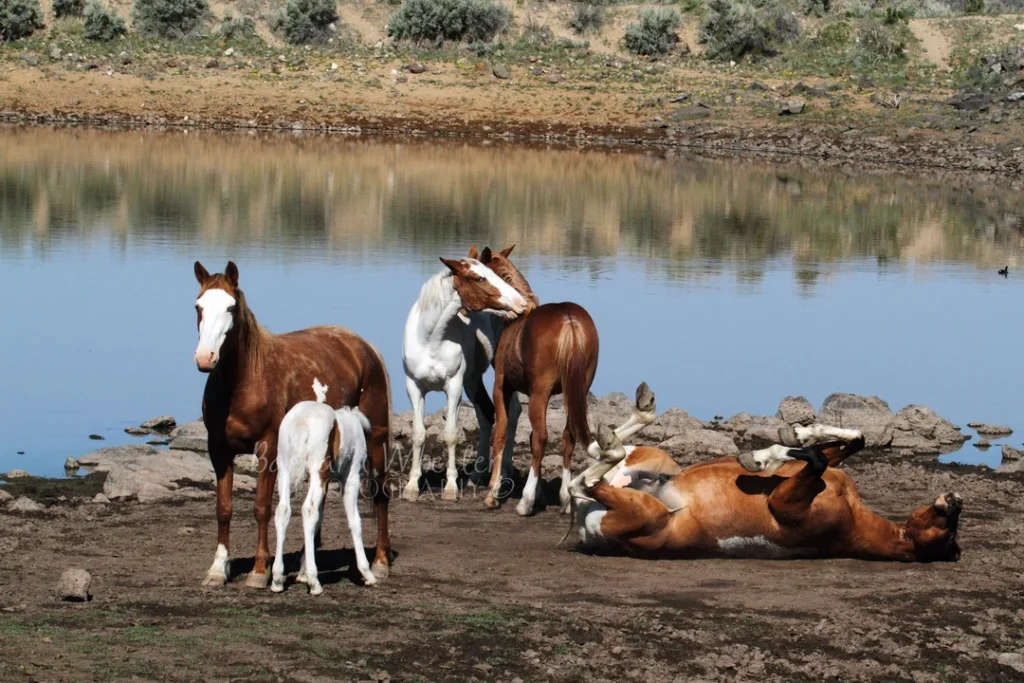
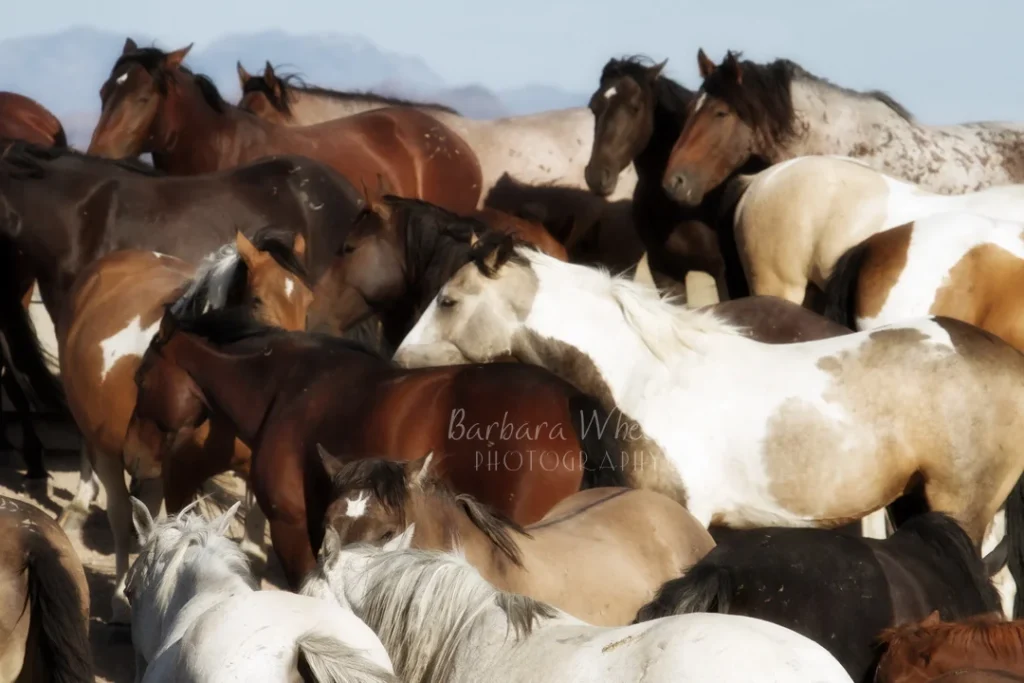
This is not all of the horses that were clustered together but there are at least three band stallions in this tight group. So cool!
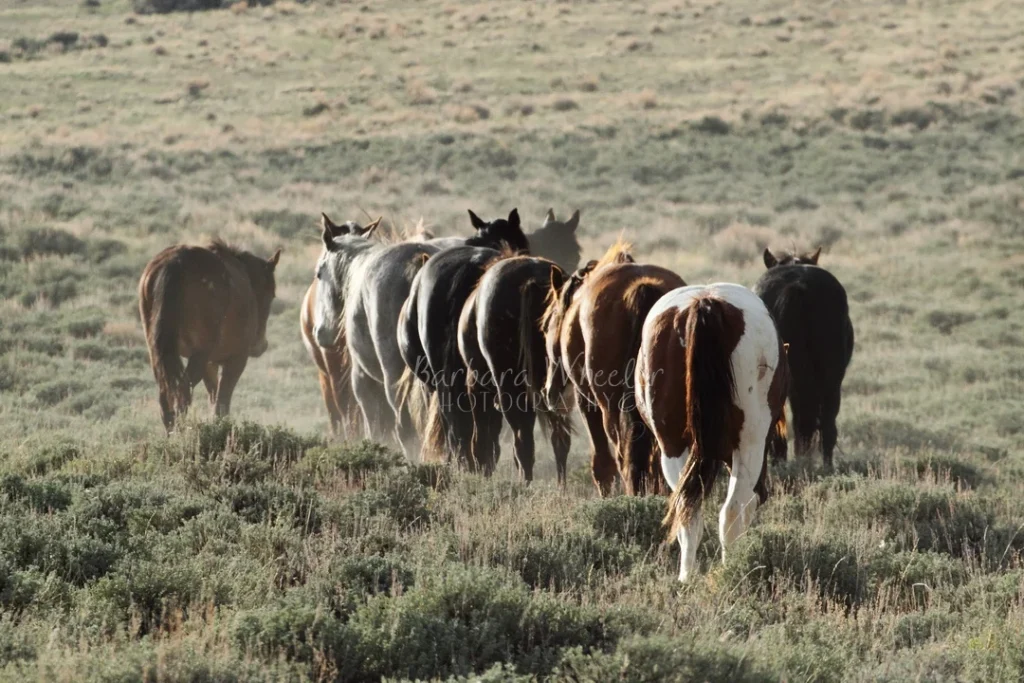
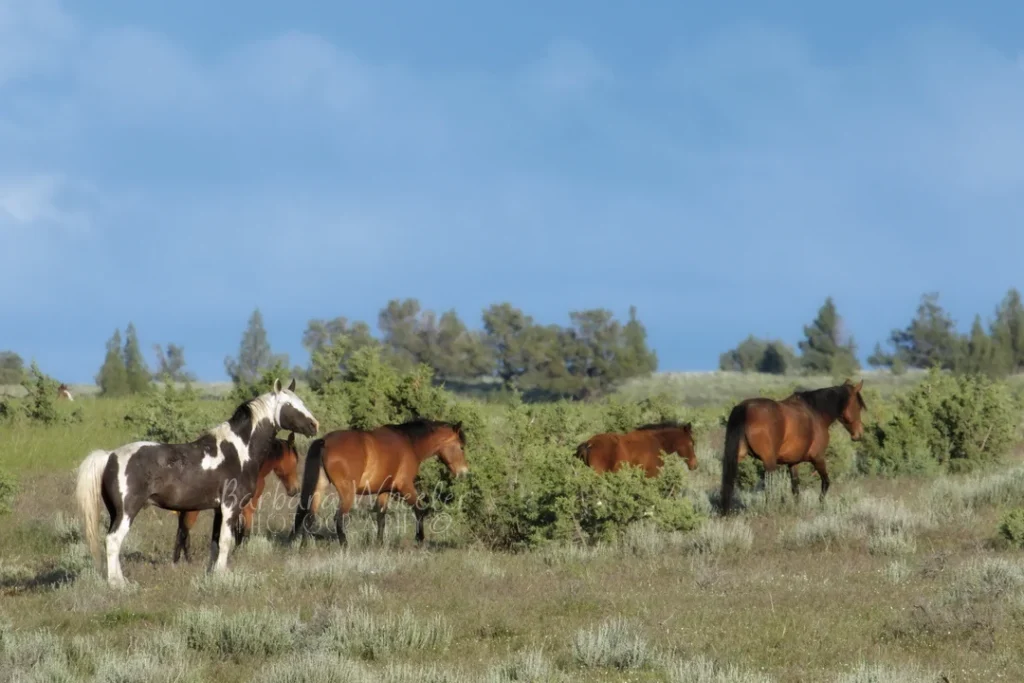
Where Did My Waterhole Go?
Sometimes you see the most hilarious things out there…
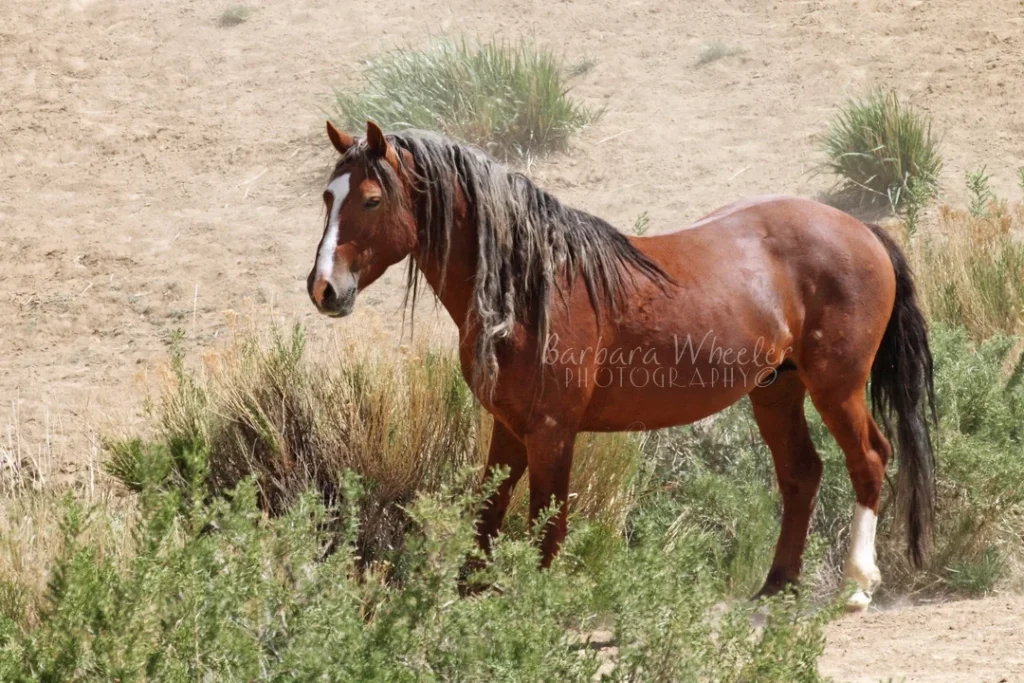
This is a scenario that took place at Sand Wash Basin HMA. Before you get overly concerned, there was ample water to be had, both here and nearby.
It looked as if the horses were confused by the fact their waterhole was empty, though I am sure this was not new. They walked around it, sniffed at it, pawed at it and generally looked mystified. There was a solar well with a trough right by the waterhole, but they acted like they were not used to it. Most of them looked at it as if it was a scary alien. They certainly didn’t like the fact that the water would suddenly start running when the level went down.
Some of the bands that came in would walk around and around the trough, taking the longest time to actually approach it. Others would stand and look at it and then leave without getting water. Others would come in faster, perhaps having already mastered their discomfort, though they still didn’t like it.
This is one band’s approach. It was agony watching this unfold. I wanted to reassure them – or something! LOL
I have shortened the length considerably so you don’t go to sleep waiting for this stallion to approach the trough…
Oh, the agony of watching this unfold! LOL
We watched a very similar scenario in Utah.
I initially thought this was a new trough and that the horses would adjust to the scary regulator. However, I was surprised when I found out that the water trough in the photo array below, which has the same toilet type mechanism to fill it, has been there for over 30 years. Maybe adjustment is relative!
By the way, that bay roan is a big, tough band stallion! 😉
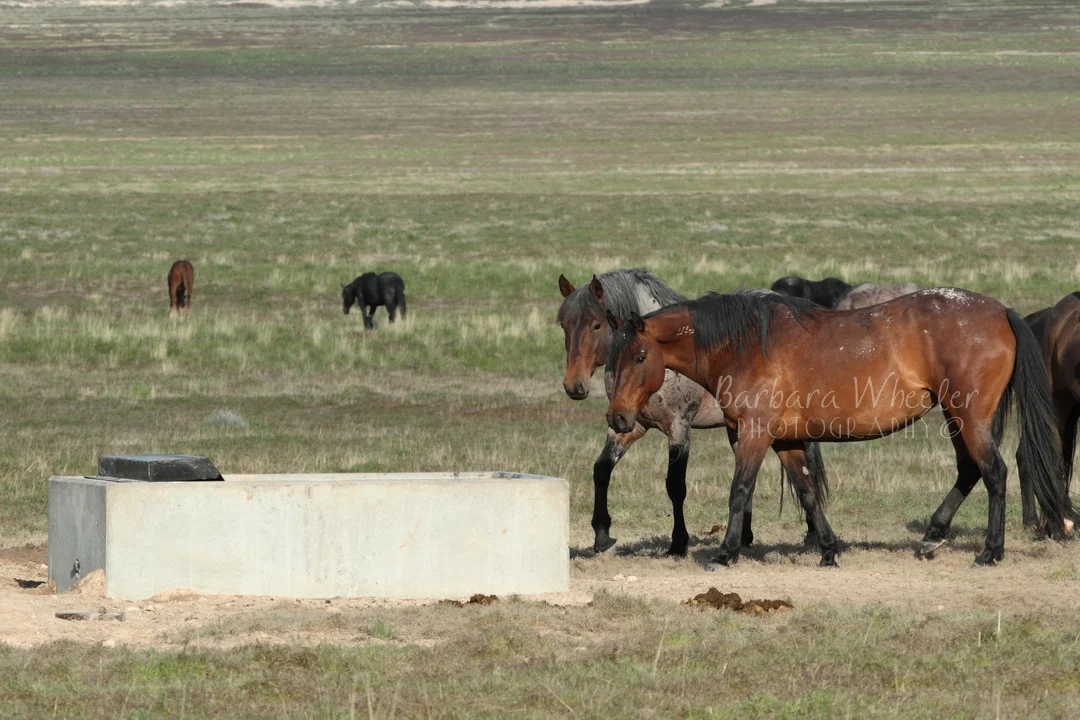
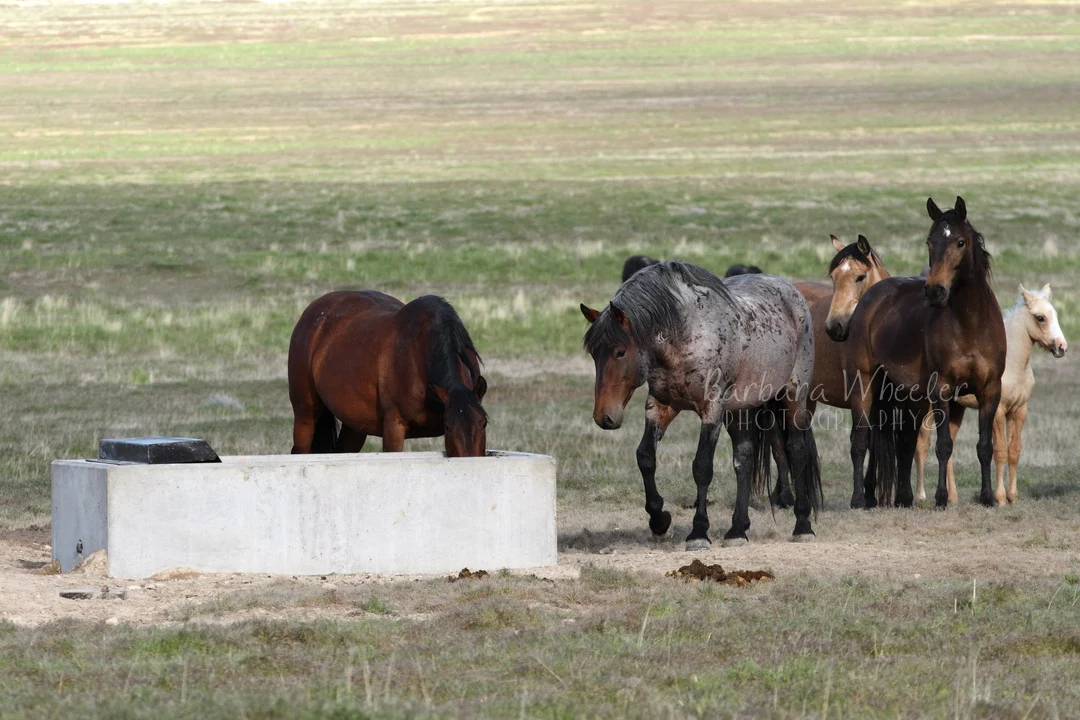
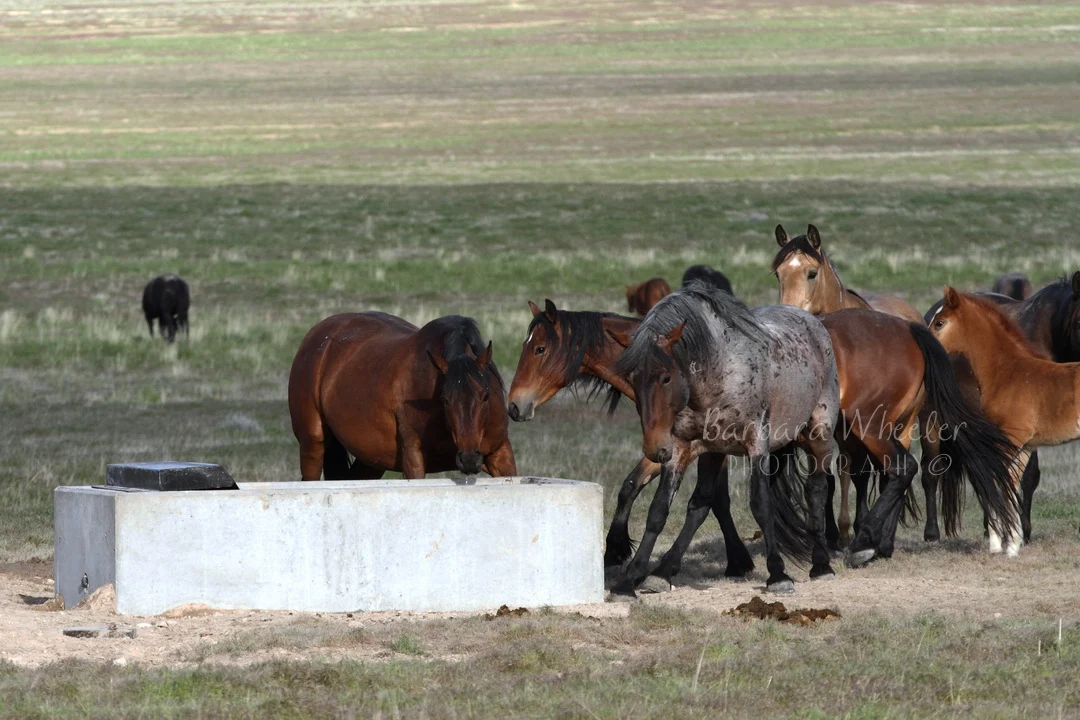
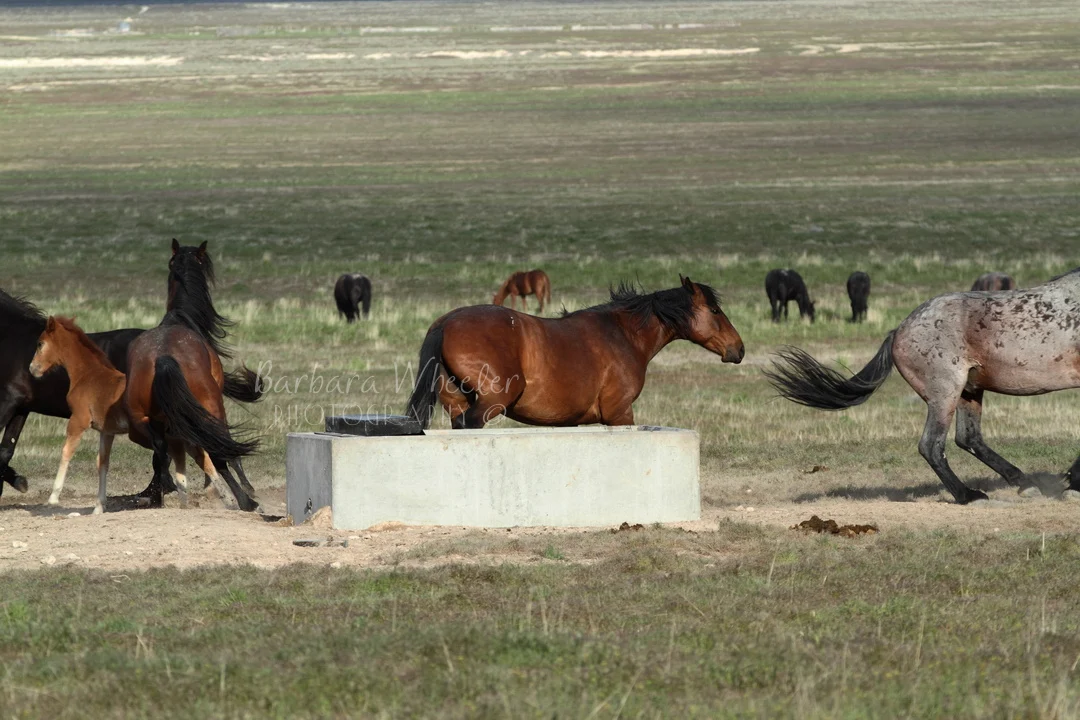
Methinks the bay mare is the braver of the two. 😉
If You’ve Got Lemons, Make Lemonade
So, what do you do if the waterhole is dry? Well….
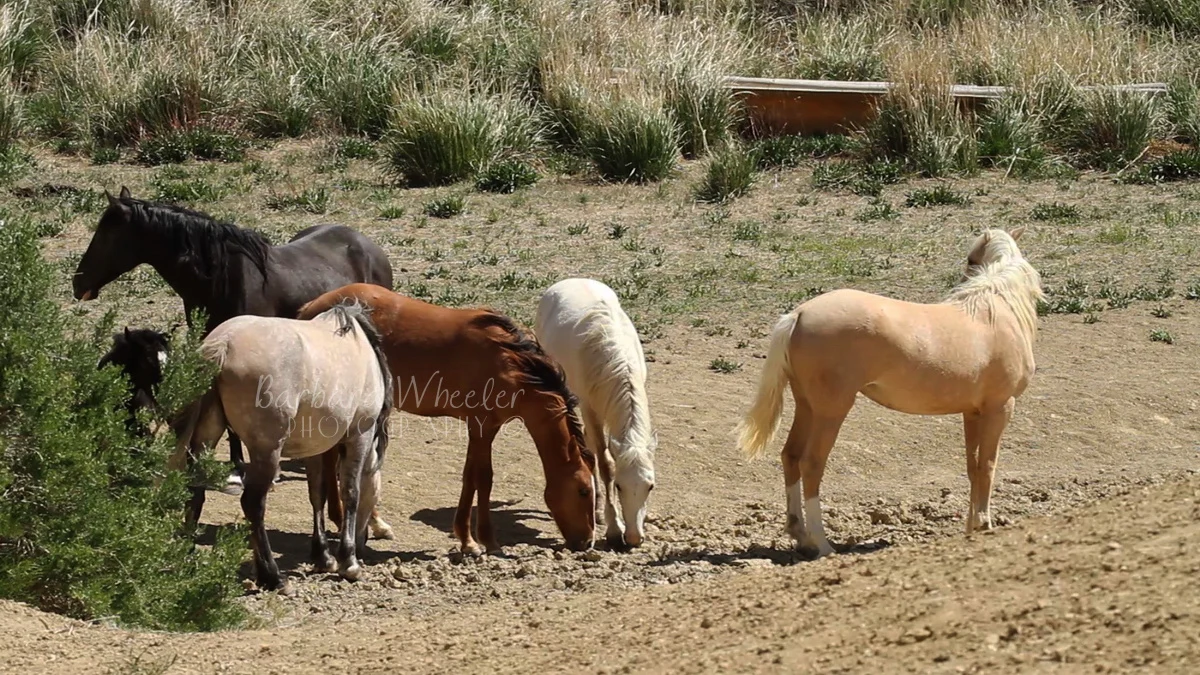
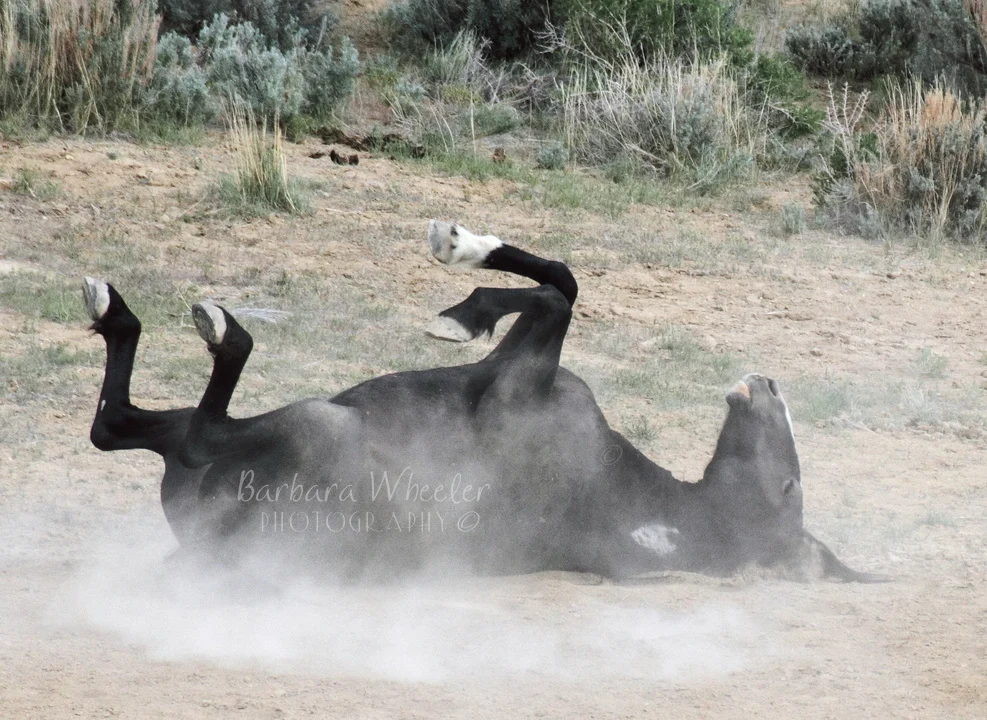
And you know what happens when one horse rolls- others follow suit, of course!
You can use it as a playground…
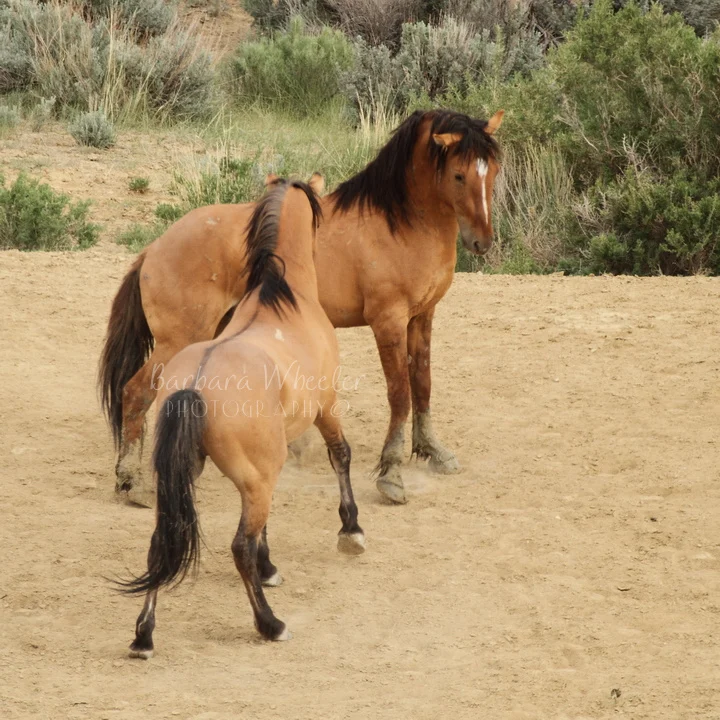
Oh yes, there are many uses…just use your imagination!
OH! The Fun We’ve had at Waterholes!
With all of that out of the way, I am just SURE that you want to see some of our favorite waterhole photos. Right?
Some of those favorites are used in this blog, but here are a few more. Trust me. I have plenty!
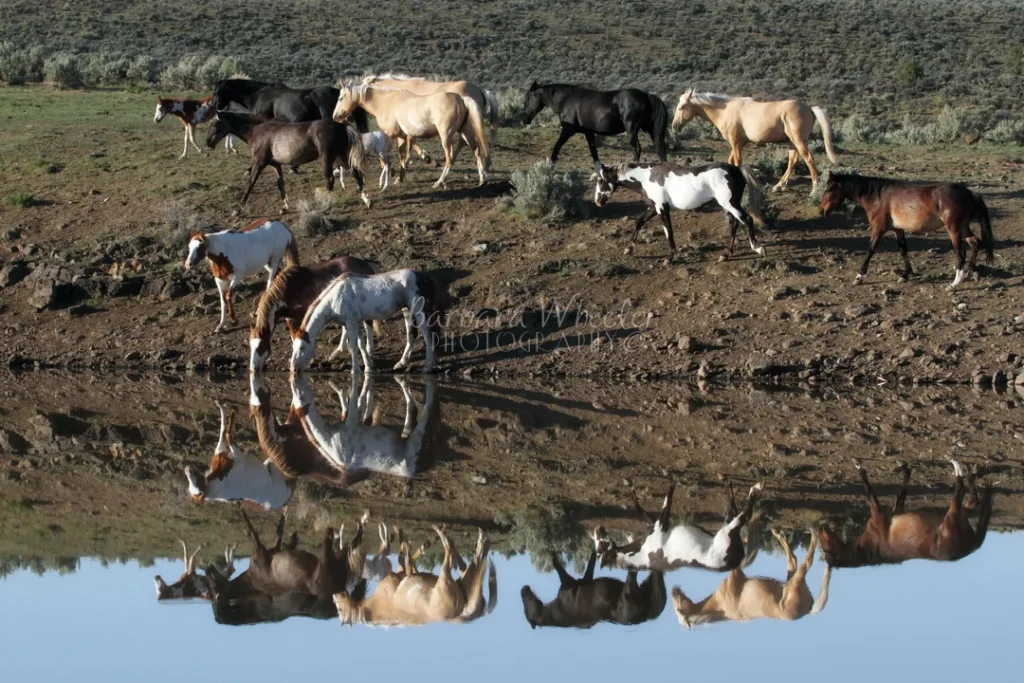
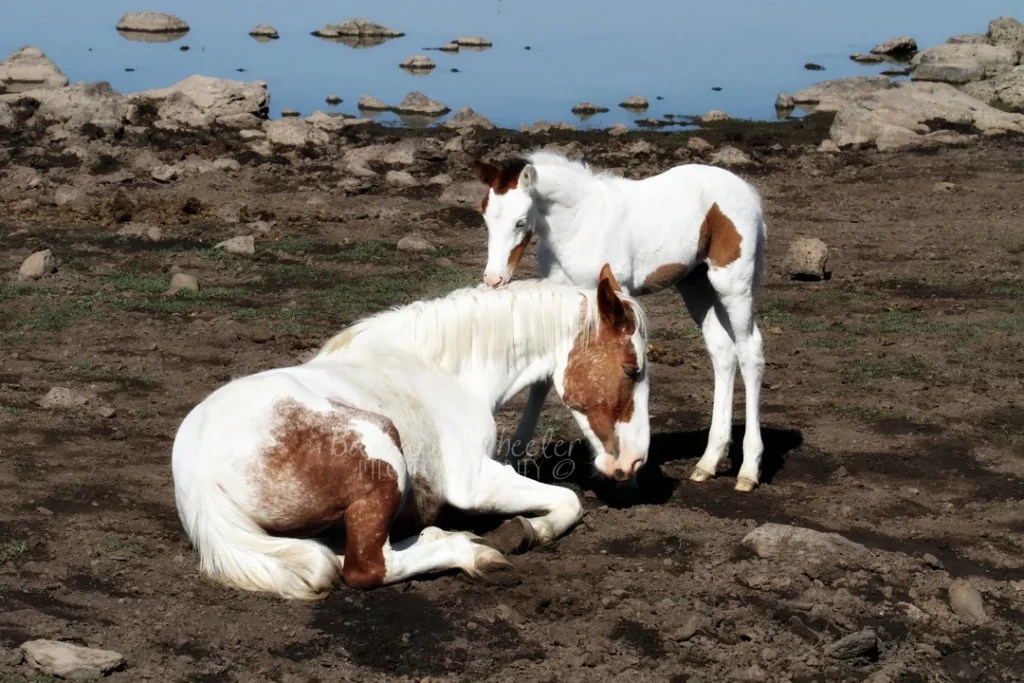
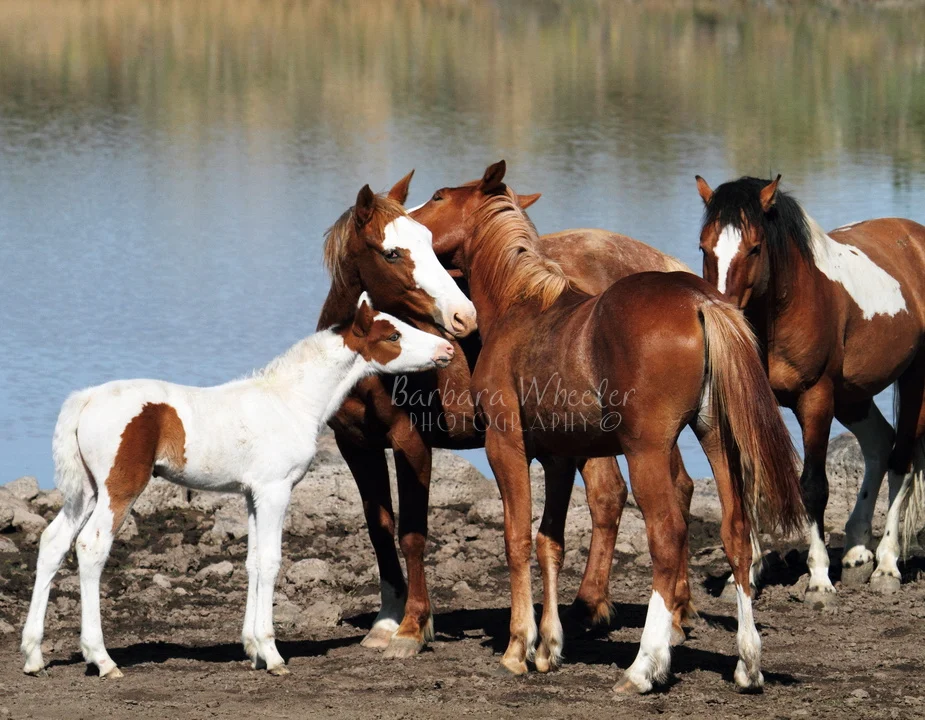
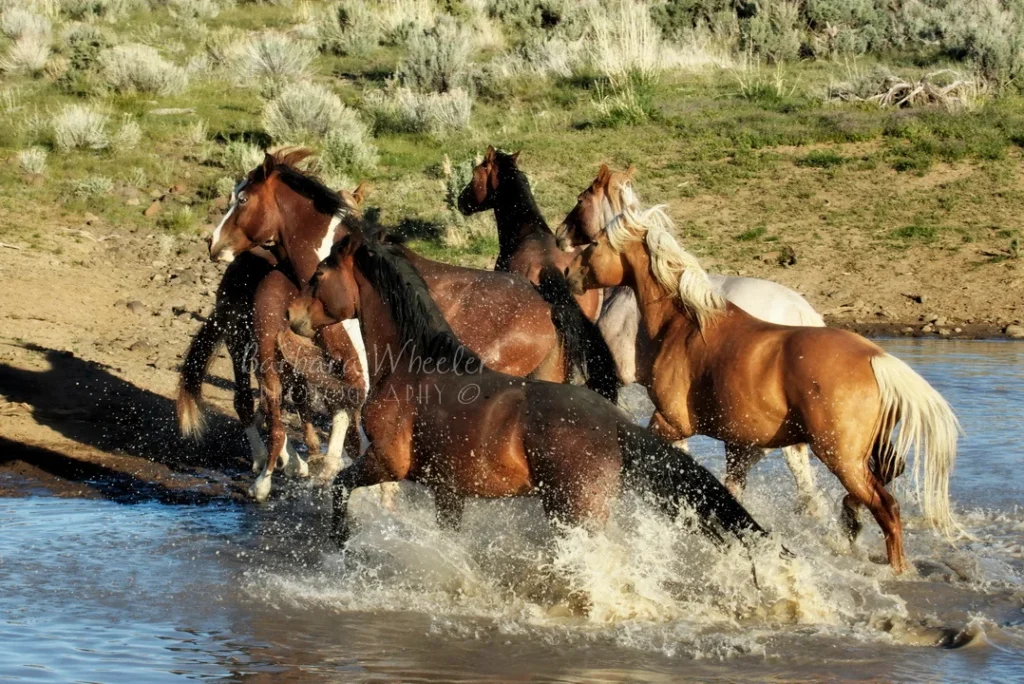
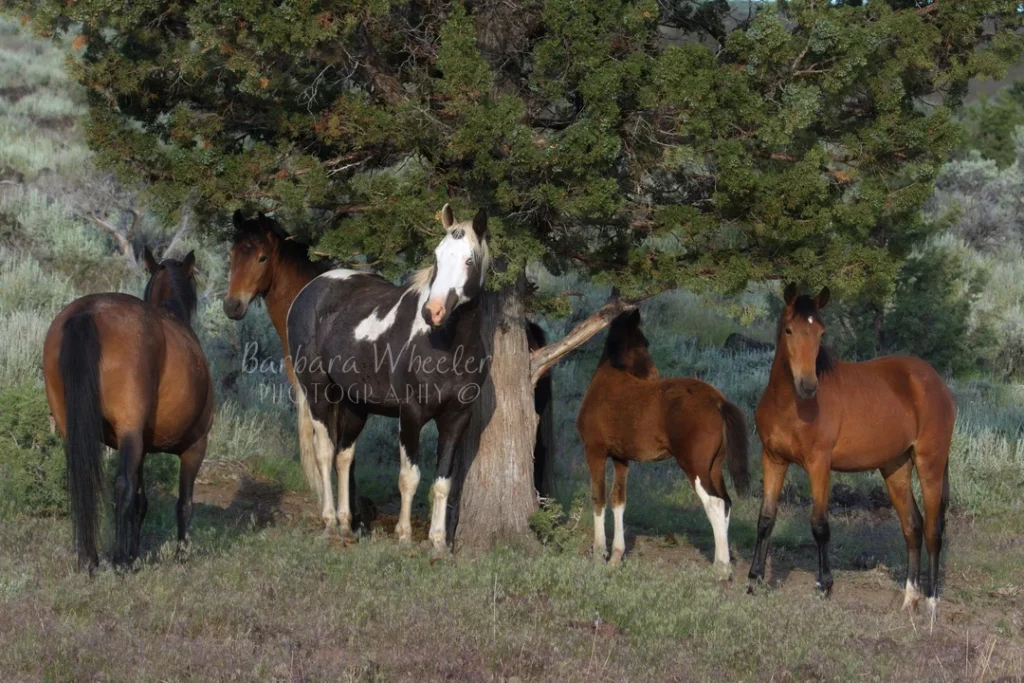
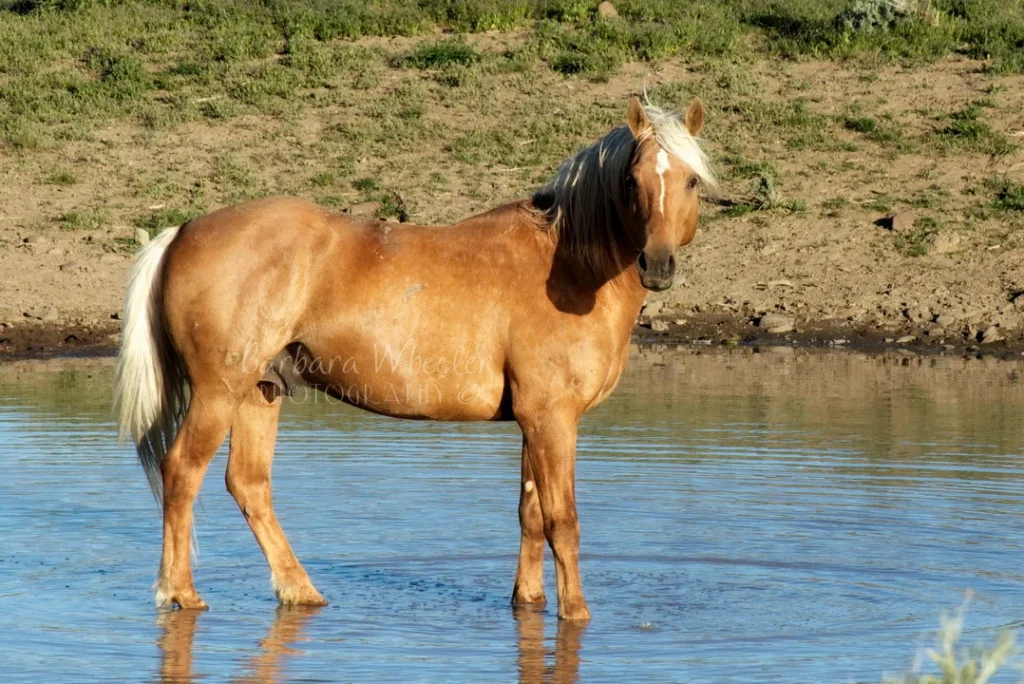
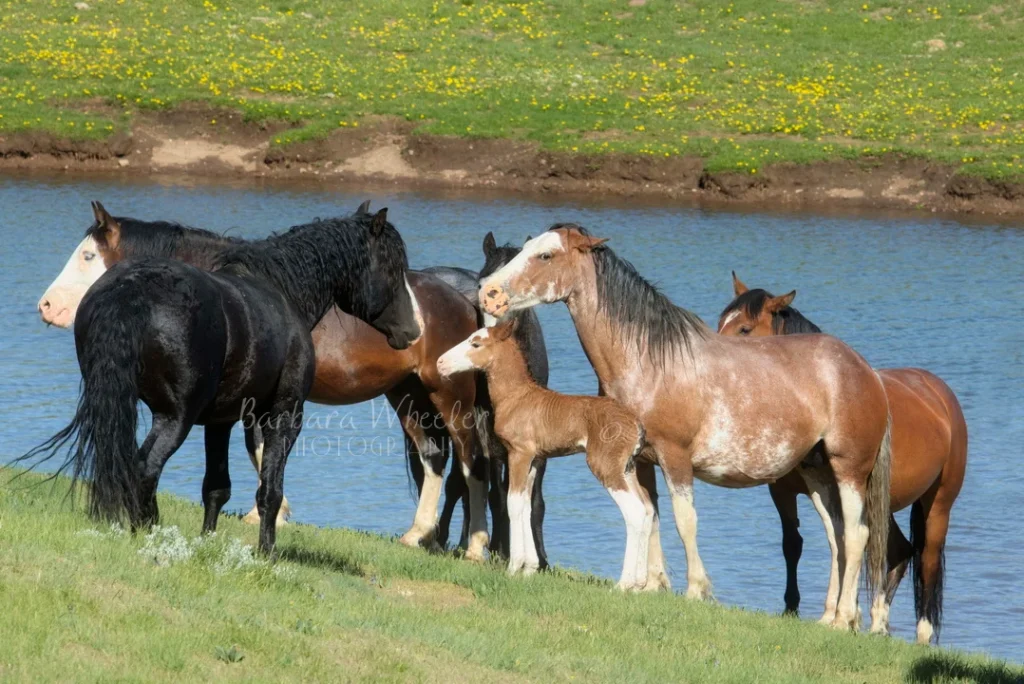
Favorite Videos, Anyone?
The Silver Bay’s band going to the waterhole, 2015
Renegade’s Band at the Waterhole, 2015
I hope you have enjoyed this blog as much as I enjoyed reliving this experience.
Please share, comment and most importantly, register for notifications of upcoming blogs and podcasts. I recorded two podcasts recently, with my friend Mary Ann Simonds. I will let you know when they are published.
If you missed my podcast interview in December, you can find it here:
I am planning to post many more blogs in the future. I expect they will be posted about once a month or so, depending on how long they are – and therefore how long they take me to write.
Please feel free to suggest topics you are interested in. It could be a specific herd, a favorite horse or behavior you are interested in. If at all possible, and I feel enough people will be interested, I will do my best to honor your suggestions.
If you followed me on my previous website, you have probably noticed this one looks very different. Yes, I have a wild horse gallery, but for now there is only one, showcasing some of our favorite images and horses. Perhaps, I will add more later but this new wild horse adventure is all about telling stories. You know I love to do that. And I think over the years, you have loved that too.
Until the next time,
Barbara
Comments
10 responses to “Wild Horses: Life at the Waterhole”
Love it!
Thank you, Nadine!
How I enjoyed this! I loved seeing the horses close-up. I loved seeing the horses I know. Thanks for including their names.
I loved the sounds – of the horses & of the water!
“Running to the Creek” – I saw the Curlies but never could find the antelope. About what time is it in the video?
I loved seeing Shaman. . . & Domino, Arrow, Renegade.
Barbara, you following the horse for 45 minutes only to find that you were at the top of a steep hill that they were going down. A bit scary. So glad that you didn’t go the entire way.
“The two stories you know” – Hilarious. Made me laugh.
Particularly loved:
Moondrinker and Stargazer leading little sis to water
Foals in the water – one that was only a few hours old
Black & white pintos – Mom & foal – in the water
White stallion at trough
Lucky Charm and Shona
Arrows Band
Is Lupine with Renegade? (In the picture and the video)
It still amazes me how Renegade steals any scene he is in.
I am so grateful for this blog, for you. It was such a lovely way to spend my time.
Thank you Susanne!
The antelope in the “Running to the Creek” video is near the end. The antelope are in the far distance (and might be hard to see on a phone).
Yes, Lupine is with Renegade in both the stills and the video.
I am grateful for you too!
a well written, comprehensive coverage of water hole lore….not unlike those gatherings around the office water cooler . The photos say it all, water sustains life while providing a cool dip in the pool. Nice work, nels
Thank, Nels!
Thank you so much for this blog!!! I love to read about these incredible creatures… as a Northeasterner these stories you write about bring the mustangs to life for me… sad to see so few foals going to the watering holes,, but they aren’t being rounded up and put into pens all their life .. can’t wait till your next blog!!
Thank YOU, Donna, for sticking with me through this monumental change! I am so glad you are here!
There are always a lot of foals going to water with their mamas. Getting a good photo or video is another story. 😉
I’m sorry there were some broken video links. I am still learning this whole new process.
Be well, my friend.
Thanks, Barbara! In addition to such interesting information, the photos and videos are fabulous. Renegade still makes my heart pound, he’s so gorgeous!
Thank you, Molly, I am glad you enjoyed it.
It looks like there are still some technical problems I need to fix. Sorry about that!!